Philadelphia Area Archives - Hidden Collections Initiatives
The Hidden Collections Initiative for Pennsylvania Small Archival Repositories (HCI-PSAR) was a project of the Historical Society of Pennsylvania, funded by grants from the Andrew W. Mellon Foundation. HCI-PSAR was designed to make better known and more accessible the often hidden collections at small archival repositories in the five-county Philadelphia region. These include volunteer-run historical institutions, museums, churches and religious institutions, schools, ethnic organizations, community groups and social service organizations, clubs, and other non-profit organizations with important archival collections. Hundreds of small archival repositories in the five-county Philadelphia region hold thousands of individual collections documenting a wide range of topics and geographic areas.
The project began in July 2011 and concluded in June 2016. HCI-PSAR staff identified small archival repositories in the Philadelphia region, surveyed and assessed their archival collections, and created summary finding aids to these collections. The finding aids were added to this website.
Jump to: Bucks County Repositories
 Bucks County Civil War Round Table Library and Museum
Bucks County Civil War Round Table Library and Museum Craven Hall Historical Society
Craven Hall Historical Society Doylestown Historical Society
Doylestown Historical Society Dublin Historical Society
Dublin Historical Society Haycock Historical Society
Haycock Historical Society Historic Carversville Society
Historic Carversville Society Historic Fallsington, Inc.
Historic Fallsington, Inc. Historic Langhorne Association
Historic Langhorne Association Historical Society of Bensalem Township
Historical Society of Bensalem Township Historical Society of Hilltown Township
Historical Society of Hilltown Township James A. Michener Art Museum Archives
James A. Michener Art Museum Archives Lower Makefield Historical Society
Lower Makefield Historical Society Margaret R. Grundy Memorial Library
Margaret R. Grundy Memorial Library New Hope Historical Society
New Hope Historical Society Newtown Historic Association
Newtown Historic Association Pearl S. Buck International
Pearl S. Buck International Perkasie Historical Society
Perkasie Historical Society Plumstead Historical Society
Plumstead Historical Society Quakertown Historical Society
Quakertown Historical Society Sellersville Museum
Sellersville Museum Solebury Township Historical Society
Solebury Township Historical Society Southampton Baptist Corporation
Southampton Baptist Corporation Springfield Township Historical Society (Bucks County, Pa.)
Springfield Township Historical Society (Bucks County, Pa.) Village Improvement Association of Doylestown
Village Improvement Association of Doylestown Warwick Township Historical Society
Warwick Township Historical Society Yardley Historical Association
Yardley Historical Association
Jump to: Chester County Repositories
 Downingtown Area Historical Society
Downingtown Area Historical Society Historic Sugartown, Inc.
Historic Sugartown, Inc. Historic Waynesborough
Historic Waynesborough Historical Society of the Phoenixville Area
Historical Society of the Phoenixville Area Kennett Township Historical Commission
Kennett Township Historical Commission Malvern Historical Commission
Malvern Historical Commission Mill at Anselma Preservation and Educational Trust
Mill at Anselma Preservation and Educational Trust Moore Archives at Historic Yellow Springs
Moore Archives at Historic Yellow Springs National Iron & Steel Heritage Museum
National Iron & Steel Heritage Museum New London Area Historical Society
New London Area Historical Society Old Eagle School
Old Eagle School Radnor Hunt Archives
Radnor Hunt Archives Tredyffrin Easttown Historical Society
Tredyffrin Easttown Historical Society Tri-County Heritage Society
Tri-County Heritage Society Upper Uwchlan Township Historic Commission
Upper Uwchlan Township Historic Commission Uwchlan Township Historical Commission
Uwchlan Township Historical Commission Wallace Township Archives
Wallace Township Archives Welkinweir
Welkinweir West Caln Township Historical Commission
West Caln Township Historical Commission West Nantmeal Township Historical Commission
West Nantmeal Township Historical Commission Westtown School Archives
Westtown School Archives Wharton Esherick Museum
Wharton Esherick Museum William M. Lennox Archives Center at Malvern Retreat House
William M. Lennox Archives Center at Malvern Retreat House
Jump to: Delaware County Repositories
 Aston Township Historical Society
Aston Township Historical Society Chadds Ford Historical Society
Chadds Ford Historical Society Chester Heights CampMeeting Association
Chester Heights CampMeeting Association Colonial Pennsylvania Plantation
Colonial Pennsylvania Plantation Chichester Historical Society
Chichester Historical Society Christian C. Sanderson Museum
Christian C. Sanderson Museum Concord Township Historical Society
Concord Township Historical Society Dabbs Woodfin Library and Archives at Newlin Grist Mill
Dabbs Woodfin Library and Archives at Newlin Grist Mill Darby Free Library
Darby Free Library Delaware County Historical Society
Delaware County Historical Society Delaware County Institute of Science
Delaware County Institute of Science Eden Cemetery
Eden Cemetery Elwyn Historical Archives and Museum
Elwyn Historical Archives and Museum Haverford Township Historical Society
Haverford Township Historical Society Marple Historical Society
Marple Historical Society Media Historic Archives Commission
Media Historic Archives Commission Nether Providence Historical Society
Nether Providence Historical Society Newtown Square Historical Society
Newtown Square Historical Society Radnor Historical Society
Radnor Historical Society Sharon Hill Historical Society
Sharon Hill Historical Society St. David's Episcopal Church Parish Archives
St. David's Episcopal Church Parish Archives Thornbury Historical Society
Thornbury Historical Society Tinicum Township Historical Society
Tinicum Township Historical Society Tyler Arboretum
Tyler Arboretum Upper Darby Historical Society
Upper Darby Historical Society Violette de Mazia Foundation
Violette de Mazia Foundation Williamson College of the Trades (Williamson Free School of Mechanical Trades)
Williamson College of the Trades (Williamson Free School of Mechanical Trades)
Jump to: Montgomery County Repositories
 Friends' Central School Archives
Friends' Central School Archives Goschenhoppen Historians, Inc.
Goschenhoppen Historians, Inc. Harcum College Archives
Harcum College Archives Highlands Historical Society
Highlands Historical Society Historical Society of Fort Washington
Historical Society of Fort Washington Historical Society of Montgomery County
Historical Society of Montgomery County The Historical Society of Trappe, Collegeville, Perkiomen Valley
The Historical Society of Trappe, Collegeville, Perkiomen Valley Horsham Preservation and Historical Association
Horsham Preservation and Historical Association John James Audubon Center at Mill Grove
John James Audubon Center at Mill Grove King of Prussia Historical Society
King of Prussia Historical Society Lansdale Historical Society
Lansdale Historical Society Limerick Township Historical Society
Limerick Township Historical Society Lower Merion Historical Society
Lower Merion Historical Society Lower Pottsgrove Historical Society
Lower Pottsgrove Historical Society Millbrook Society
Millbrook Society Montgomery Township Historical Society
Montgomery Township Historical Society Old York Road Historical Society
Old York Road Historical Society Pennypacker Mills
Pennypacker Mills Plymouth Meeting Historical Society
Plymouth Meeting Historical Society Pottsgrove Manor
Pottsgrove Manor Pottstown Historical Society
Pottstown Historical Society Richard Wall House Museum
Richard Wall House Museum Springfield Township Historical Society (Montgomery County, Pa.)
Springfield Township Historical Society (Montgomery County, Pa.) Spring-Ford Area Historical Society
Spring-Ford Area Historical Society St. James Community History Center
St. James Community History Center Sunrise Mill
Sunrise Mill Union Library of Hatboro
Union Library of Hatboro Upper Moreland Historical Association
Upper Moreland Historical Association Welsh Valley Preservation Society
Welsh Valley Preservation Society Wissahickon Valley Historical Society
Wissahickon Valley Historical Society Wissahickon Valley Watershed Association
Wissahickon Valley Watershed Association Worcester Historical Society
Worcester Historical Society
Jump to: Philadelphia County Repositories
 African American Museum in Philadelphia
African American Museum in Philadelphia African Episcopal Church of St. Thomas
African Episcopal Church of St. Thomas American Swedish Historical Museum
American Swedish Historical Museum Archives of the Associated Alumni of the Central High School of Philadelphia
Archives of the Associated Alumni of the Central High School of Philadelphia Awbury Arboretum
Awbury Arboretum Bridesburg Historical Society
Bridesburg Historical Society Byberry Library
Byberry Library The Center for Art in Wood
The Center for Art in Wood Charles Albert Tindley Institute
Charles Albert Tindley Institute Chestnut Hill Historical Society
Chestnut Hill Historical Society Christ Church Archives
Christ Church Archives Cliveden of the National Trust
Cliveden of the National Trust East Falls Historical Society
East Falls Historical Society Eastern State Penitentiary
Eastern State Penitentiary Eugenio M. de Hostos Archives at Taller Puertorriqueño
Eugenio M. de Hostos Archives at Taller Puertorriqueño Fairmount Park Historic Resource Archives
Fairmount Park Historic Resource Archives Fireman's Hall Museum
Fireman's Hall Museum First Unitarian Church of Philadelphia Archives
First Unitarian Church of Philadelphia Archives Friends of Northeast Philadelphia History
Friends of Northeast Philadelphia History Germantown Historical Society
Germantown Historical Society Germantown Mennonite Historic Trust
Germantown Mennonite Historic Trust Glen Foerd on the Delaware
Glen Foerd on the Delaware Grand Army of the Republic Civil War Museum and Library
Grand Army of the Republic Civil War Museum and Library Greek American Heritage Museum
Greek American Heritage Museum The Henry George Birthplace, Archive and Historical Research Center
The Henry George Birthplace, Archive and Historical Research Center The Historical and Interpretive Collections of The Franklin Institute
The Historical and Interpretive Collections of The Franklin Institute Historical Society of the Eastern Pennsylvania Conference of the United Methodist Church
Historical Society of the Eastern Pennsylvania Conference of the United Methodist Church Historical Society of Frankford
Historical Society of Frankford Historical Society of Tacony
Historical Society of Tacony John Bowman Bartram Special Collections Library
John Bowman Bartram Special Collections Library John Gloucester Memorial and Historical Society
John Gloucester Memorial and Historical Society John J. Wilcox Jr. GLBT Archives of Philadelphia
John J. Wilcox Jr. GLBT Archives of Philadelphia Johnson House Historic Site
Johnson House Historic Site Laurel Hill Cemetery
Laurel Hill Cemetery Mikveh Israel Archives
Mikveh Israel Archives Morris Arboretum Archives
Morris Arboretum Archives Museum of the American Revolution
Museum of the American Revolution Mummers Museum
Mummers Museum Pennepack Baptist Historical Foundation
Pennepack Baptist Historical Foundation Philadelphia Clef Club of Jazz and Performing Arts
Philadelphia Clef Club of Jazz and Performing Arts Philadelphia Folksong Society
Philadelphia Folksong Society Philadelphia History Museum
Philadelphia History Museum Philadelphia Sketch Club
Philadelphia Sketch Club Philadelphia Society of Free Letts
Philadelphia Society of Free Letts Richard Allen Museum Archives
Richard Allen Museum Archives Roxborough Manayunk Wissahickon Historical Society
Roxborough Manayunk Wissahickon Historical Society Ryerss Museum and Library
Ryerss Museum and Library St. Peter's Episcopal Church
St. Peter's Episcopal Church Stenton
Stenton Strawberry Mansion
Strawberry Mansion Villiger Archives of St. Joseph's Preparatory School
Villiger Archives of St. Joseph's Preparatory School The Wilma Theater
The Wilma Theater Woodford Mansion
Woodford Mansion Woodlands Mansion and Cemetery
Woodlands Mansion and Cemetery Woodmere Art Museum
Woodmere Art Museum
About the Repositories
 |
1st Regiment Infantry MuseumThe 1st Regiment Infantry, Pennsylvania, or "The Dandy First," is recognized by the United States Army as the oldest continuously existing command in the Pennsylvania National Guard, and the only existing Pennsylvania unit with service in the Continental Army, representing Pennsylvania. Now designated the 103rd Engineer Battalion Pennsylvania Army National Guard, the unit has fought in nearly every major American war, initially being involved in the French and Indian War and then the Revolutionary War. The 103rd Engineer Battalion Armory today houses the 1st Regiment Infantry Museum dedicated to the history of this storied command. Its archival collections are comprised of over 100 linear feet of materials dating from 1812, including regiment minute books, roll books, officers' letter books, account books, and photograph albums.
|
 |
African American Museum in PhiladelphiaFounded in 1976 in celebration of the US Bicentennial, the African American Museum in Philadelphia is the nation's first institution funded and built by a major municipality to preserve, interpret, and exhibit the heritage of African Americans. The Museum is committed to telling the story of African Americans in all its permutations: family life, the Civil Rights movement, arts and entertainment, sports, medicine, architecture, politics, religion, law and technology. The Museum holds over 350 linear feet of archival materials dating from the mid 19th century to the present. The archival collections include the papers of famous individuals, including singer Pearl Bailey, pianist Natalie Hinderas, and Philadelphia politician Joseph E. Coleman, as well as less well-known African American performers, athletes, educators, physicians, artists, and other citizens. Materials include family and personal papers, such as correspondence, scrapbooks, and certificates; organizational records, such as minute books, financial documents, and by-laws; and photographs, artwork, posters, architectural drawings, and numerous other document types. The focus of the collections is on the Philadelphia area, although other geographic regions are also covered.
|
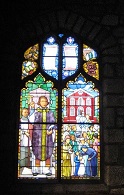 |
African Episcopal Church of St. ThomasThe Historical Society of the African Episcopal Church of St. Thomas was organized in 1982 to preserve, research, study, and communicate the history of the parish. Established in 1792 in Philadelphia, Pennsylvania by and for persons of African descent, the African Episcopal Church of St. Thomas is the first African American Episcopal Church in the United States. Its founder and first rector was Absalom Jones (1746-1818), the first African American ordained in the Episcopal Church. Records of the Church make up the vast bulk of the Historical Society's archival holdings -- about 50 linear feet of the total holdings of 60 linear feet. The church records, which date from 1790 to the present, consist mainly of original church records, as well as some accumulated secondary-source materials. The records also include photographs, audio-visual materials, printed materials, and objects. Additionally, the Historical Society is the repository of several collections of late 20th century materials compiled by prominent church members, primarily documenting church operations, commemorations of Reverend Jones and the church's history, and African American Episcopalians.
|
 |
American Swedish Historical MuseumThe American Swedish Historical Museum in Philadelphia is the oldest Swedish Museum in the United States. Founded in 1926, the Museum has been dedicated to preserving and promoting Swedish and Swedish-American cultural heritage and traditions for more than 80 years.
The archival collections of the American Swedish Historical Museum are comprised of materials relating to Swedish and Swedish-American culture and history. These materials include papers of prominent individuals, such as Jenny Lind and John Ericsson, as well as of community organizations. The archival collections comprise 79 linear feet of materials and span from 1702 to 1994.
|
 |
Andalusia FoundationThe Andalusia Foundation was established in 1980 by James Biddle (1929-2005) and other Biddle family members to ensure the preservation of the family's ancestral home, Andalusia. Overlooking the Delaware River in Bucks County, PA, Andalusia has been the home to generations of Philadelphia's Biddle family since 1814, when Nicholas Biddle and his wife, Jane Craig, inherited the property from her parents. Nicholas and other Biddle family members became prominent among their contemporaries in various fields such as banking, diplomacy, law, politics, military service, agriculture, and horticulture. In addition, the family was friendly with a number of historically important figures, including presidents and foreign dignitaries, and often hosted them at Andalusia. The Andalusia Foundation stewards approximately 70 linear feet of Biddle family papers, dating from 1747 to the present, which are stored at Andalusia. Various family members are represented in the collection through correspondence, diaries, financial records, legal records, scrapbooks, draft and published articles, pamphlets and ephemera, deeds, photographs, and numerous other materials. There is also some secondary-source material in the collection pertaining to the Biddle family and the administration of Andalusia, such as newspaper clippings, articles, photocopies of original documents held at other repositories, pamphlets and ephemera, floor plans and other building-related materials, and genealogical research and information on the Biddles and related families.
|
 |
The Archives at the School in Rose ValleyThe School in Rose Valley (SRV), located in Rose Valley, Delaware County, Pennsylvania, was established in 1929 as a progressive school based on the principles of philosopher and educator John Dewey. As of 2016, SRV remains a progressive, co-educational, non-sectarian school that educates children in preschool through sixth grade. The School aims to create experiences that arouse curiosity, stretch muscles, strengthen initiative, and stimulate questions, guiding children to know themselves, to delight in learning, and to understand their opportunities and responsibilities in the community and the world with a focus on hands-on experiences and a connection to nature. The Archives at the School in Rose Valley consist of 65 linear feet of materials dating from 1938 to the present and include SRV's institutional records, such as administrative and financial records; teaching materials; student publications; a variety of visual, audio, and audiovisual items; and other materials that document the School in Rose Valley and the experiences of its students, faculty, and families.
|
 |
Archives of the Associated Alumni of the Central High School of PhiladelphiaThe Archives of the Associated Alumni of the Central High School (AACHS) of Philadelphia are housed in the Barnwell Library at Central High School in Philadelphia, Pennsylvania. The Central High School of Philadelphia is the second oldest continuous public high school in the United States. Chartered in 1836 as an all-boys school, its first building opened in 1838. In 1983, Central began admitting female students. The Associated Alumni of the Central High School of Philadelphia traces its roots to the school's first graduating class in June 1842 and its archives aim to document and preserve the unique legacy and culture of Central High School, its alumni, students, and community. The archives encompass about 200 linear feet of materials, which date from 1818 to the present and include school records, alumni materials, and subject files that contain scrapbooks, yearbooks, minute books, letters, correspondence, and other materials. Of special interest are records documenting notable alumni, such as Dr. Albert C. Barnes, Thomas Eakins, Louis Kahn, and Alain Locke, as well as visitors including United States presidents James K. Polk and Theodore Roosevelt.
|
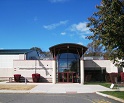 |
Aston Township Historical SocietyAston Township Historical Society in Delaware County, Pennsylvania was founded in 1993 to promote efforts to identify, preserve, and enhance the properties of historical value or interest to the residents of Aston Township; to collect historical information and material and maintain archives; to provide education, information, and other associated services; and to preserve the Village Green School on Pennell Road. Aston Township Historical Society's archival holdings consist of over 75 linear feet of materials dating from 1806 to the present and include various local history materials such as, organizational, church, township, and school records; scrapbooks and photographs; subject and vertical files; and other materials that document the history, residents, businesses, and other aspects of Aston Township. The Society's holdings also include its own administrative records that document the organization and its collections and members.
|
 |
Awbury ArboretumThe mission of the Awbury Arboretum Association is to preserve and interpret Awbury's historic house and landscape, thereby connecting an urban community with nature and history. In 1852 Henry Cope purchased 40 acres of land in the East Germantown section of Philadelphia, where he built a home for his growing family. Over the next 70 years his descendants build 24 houses representing a variety of architectural styles. A portion of this land, now known as the Awbury Arboretum, was left to the City Parks Association in 1916 to protect it from development.
The Awbury Arboretum Archives collects and preserves photographs, records, books, maps, site plans, prints, oral histories, artifacts and more relating to: the history of Awbury's landscape and buildings, members of the Cope family who have lived at Awbury or nearby, life at Awbury since the mid nineteenth century, the City Parks Association, and the history of Quakerism and Germantown. The Awbury Arboretum Archives is comprised of over 50 linear feet of archival materials dating from 1791 to the present.
|
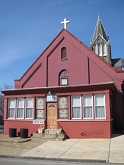 |
Bridesburg Historical SocietyThe Bridesburg Historical Society was established in 1989 to gather and preserve the history of the neighborhood, making the stories of past generations available for today's and tomorrow's generations. Bridesburg is a neighborhood in lower Northeast Philadelphia, Pennsylvania, bounded by the Delaware River and the Frankford Creek. It was originally known as Kirkbridesburg after Joseph Kirkbride, a prominent citizen who owned much land in the area and operated a ferry across the Frankford Creek, but the name was eventually shortened to Bridesburg. The community began to form around 1800, and industry moved into the area with the establishment of the U.S. Arsenal on Frankford Creek (commonly known as the Frankford Arsenal) in 1816 and the Bridesburg Manufacturing Company in 1820. With these industries the community grew, and Bridesburg was incorporated as a borough in 1848. It became part of the City of Philadelphia in the 1854 Act of Consolidation. The Bridesburg Historical Society's collections contain materials relating to the history, culture, and industry of the neighborhood. The archival holdings total 10 linear feet of materials dating from 1816 to 2012.
|
 |
Bucks County Civil War Round Table Library and MuseumThe Bucks County Civil War Round Table Library and Museum in Doylestown, Pennsylvania was established by the Bucks County Civil War Round Table in 2003 to serve as a center for the advancement of history and Civil War research and the preservation of Pennsylvania's participation in America's great conflict. The Museum and Library houses approximately 5 linear feet of archival materials, dating from 1861 to the present, although most materials date from 1861 to 1900. Primary source materials include correspondence, administrative and financial military records, and photographs. There is also some accumulated secondary-source material, such as research notes, newspaper clippings, narrative histories, and other items, most of which relate to those involved in the Doylestown-based 104th Pennsylvania Volunteer Infantry regiment, their descendants, and the monument to the 104th regiment in the Borough of Doylestown.
|
 |
Byberry LibraryByberry Library was established in 1794 as a private community library for the residents of the Township of Byberry in the County of Philadelphia. While no longer an active library, it is the repository of a large book collection (including many rare books), a local history collection, various records of the Byberry Friends Meeting, and the records of two inactive local organizations: the Byberry Library Company (est. 1794) and the Byberry Philosophical Society (est. 1829). Byberry Library is administered by the Trustees of Byberry Monthly Meeting of Friends, Inc. Byberry Friends Meeting has a rich history, both as one of Pennsylvania's earliest Quaker meetings--Quaker settlers began meeting for worship in Byberry in 1683--and as a center of learning and social and community activism. Noted abolitionist Robert Purvis (1810-1898) settled in Byberry and was active in the community from the 1840s to the 1870s. Total archival holdings comprise about 13 linear feet of materials spanning the years 1682 to 2002 (bulk 1970-2000).
|
 |
The Center for Art in WoodThe Center for Art in Wood in Philadelphia, Pennsylvania was established in 1986 as the Wood Turning Center. Its mission is to continue being the preeminent arts and education organization advancing the growth, awareness, appreciation and promotion of artists and the creation and design of art in wood and wood in combination with other materials. In addition to its museum collection of over 1,000 objects ranging from functional objects to contemporary sculpture in wood, the Center's Fleur and Charles Bresler Research Library contains over 25,000 artists' files and 1,800 books. There is also a large video collection, consisting of artists' profiles, recordings of event proceedings, and instructional videos. Additionally, the Center is a repository for archival collections from various artists, researchers studying art in wood, and other sources. The largest of these, comprising nearly one third of the Center's total archival holdings, is the records of the John Grass Wood Turning Company (1910-1952, 1993-2002). In operation from 1863 to 2003, the Grass company specialized in creating tool handles, flag poles, furniture legs, and other wooden objects shaped on a lathe.
|
 |
Chadds Ford Historical SocietyThe Chadds Ford Historical Society (CFHS) in Delaware County, Pennsylvania, is a private, non-profit, community-based volunteer organization that has restored and maintains three pre-Revolutionary War era buildings which are open to the public as house museums. The Society's mission is to preserve the properties, records, and artifacts; to interpret the history; and to educate the public concerning the way of life in the Chadds Ford area with emphasis on the eighteenth century. The Society's archival collection spans approximately 27 linear feet of materials dating from 1796 to the present, including family papers, deeds, newspapers, marriage certificates, correspondence, receipts, broadsides, photographs, and maps that document the people, places, and landscape of the Chadds Ford area. Of special interest are the Dr. Benjamin S. and Dr. Isaac Anderson account books, 1821-1905, which consist of 32 ledgers documenting the medical practice of two eminent area physicians. The Society also houses the records of the Brandywine Battlefield Task Force.
|
 |
Charlestown Historical SocietyCharlestown Historical Society was founded in 1973 as a non-profit, non-political organization whose aim was and is to provide future generations with a small "window on the past," showing through artifacts and records what life was like in this quiet Chester County, Pennsylvania farming community in the 19th century. The Society's archival holdings, which total over 50 linear feet of materials dating from the early 1700s to the present, include photographs, slides, deeds, maps and atlases, family papers, farming records, business records, school and municipal records, newspaper clippings, scholarly articles, research notes, ephemera, scrapbooks and various other materials collected from local people and organizations.
|
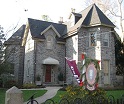 |
Chestnut Hill Historical SocietyFounded in 1967, the Chestnut Hill Historical Society is dedicated to preserving and nurturing the historical, physical, and cultural resources, and the character of Chestnut Hill. The Chestnut Hill Historical Society maintains a professionally managed collection of more than 20,000 archival items and three-dimensional artifacts documenting the community's architectural and social history from the 1680s to the present. The archival holdings include architectural drawings and building records; more than 11,000 photographic images; maps and real estate atlases from before 1849 through the 1955; and prints, drawings, deeds, diaries, genealogical materials, books, and taped and transcribed oral histories.
|
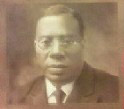 |
Charles Albert Tindley InstituteThe Charles Albert Tindley Institute (CATI), housed at Tindley Temple United Methodist Church in Philadelphia, Pennsylvania, preserves and promotes the life and legacy of Dr. Charles Albert Tindley, pastor at the church from 1902 to 1933. Dr. Tindley was one of the first preachers to incorporate song with the delivery of his sermons and is considered one of the progenitors of gospel music. CATI holds about 100 linear feet of records of the church, founded in 1837 as the John Wesley Methodist Episcopal Church and renamed Tindley Temple United Methodist Church in 1927. The Tindley Temple United Methodist Church records date from circa 1900 to the present and consist of membership records, church Trustee records, property and building-related documents, administrative papers, financial records, programs from church services and other events, recordings, photographs, and papers of and research on church reverends. Of note are a small amount of materials from Charles A. Tindley, including photographs of him and his original sermon outlines.
|
 |
Chester Heights CampMeeting AssociationEstablished in 1872, Chester Heights CampMeeting Association (CHCMA), located in Chester Heights, Delaware County, Pennsylvania, is a non-profit interdenominational religious organization dedicated to the evangelical ministry of proclaiming Christianity to the world. As of 2016, CHCMA continues to host an annual summer concert series, as well as walking tours, membership meetings, banquets, and annual service days. Its camp meeting site was added to the National Register of Historic Places in 2001. CHCMA's organizational records total approximately 12 linear feet of materials dating from 1812 to the present (bulk 1920-2016), including administrative and financial records, legal documents, photographs, scrapbooks, and other materials relating to the CHCMA and other camp meetings and camp meeting organizations.
|
 |
Chichester Historical SocietyFounded in the 1980s, the mission of the Chichester Historical Society is to preserve and share Chichester's rich history and heritage with the public. The Society focuses on the broader Chichester region of Delaware County, Pennsylvania, encompassing the townships of Upper Chichester and Lower Chichester as well as the boroughs of Marcus Hook and Trainer. The Socety's archival holdings, which consist primarily of secondary-source materials such as newspaper clippings, copies of historical documents and photographs, and pamphlets and ephemera, with a small amount of original and primary-source documents, span approximately 10 linear feet of materials dating from 1880 to the present.
|
 |
Christ Church ArchivesEstablished in 1695, Christ Church is an Episcopal church located in the Old City section of Philadelphia, Pennsylvania. Christ Church is the oldest Episcopal congregation in Pennsylvania and has been called the "Nation's Church," due to the many founding fathers of the United States who attended services there and the important role the church played during the Revolutionary War period. Several notable Philadelphians attended services at Christ Church including Benjamin Franklin, Betsy Ross, and members of the Continental Congress. As of 2016, Christ Church is an active Episcopal congregation that still regularly holds worship services and serves as home to many community organizations. The Christ Church Archives holds approximately 200 linear feet of materials dating from 1695 to the present, including church minutes, financial records, photographs, and other materials, as well as the records of affiliated institutions such as Christ Church Hospital (now the Kearsley Home), Episcopal Academy, Christ Church Preservation Trust, and Christ Church Chapel. There are also some records of St. James Church (prior to 1828) and Saint Peter's Episcopal Church (prior to 1832), which were united with Christ Church until 1828 and 1832, respectively.
|
 |
Christian C. Sanderson MuseumThe Christian C. Sanderson Museum, located in Chadds Ford, Delaware County, Pennsylvania, was founded in 1967. The museum exhibits the eclectic collection of historical relics, artifacts, and memorabilia acquired over a period of more than 75 years by Christian Sanderson (1882-1966), an historian, collector, teacher, musician, lecturer, and radio broadcaster who spent most of his life in the Chadds Ford area. The Museum's mission is to interpret United States history through one manB!B/s life and through his collection, by providing a captivating and personal museum experience in an historic 19th century home, for families, students, historians, and educators. In addition to three-dimensional objects, the museum holds about 100 linear feet of archival materials dating from 1842 to 1966. These documents were created by Sanderson, by organizations in which he was involved, or by his family members; or were collected by Sanderson from various sources. Included are diaries, correspondence, ephemera, notes, postcards, scrapbooks, slides and scripts from lectures given by Sanderson, photographs, financial records, and more. Of particular interest are paintings and materials relating to the Wyeth family of artists -- N.C. Wyeth, Andrew Wyeth, Jamie Wyeth, and others -- who lived in Chadds Ford and befriended Sanderson.
|
 |
Cliveden of the National TrustIn 1767, prominent Pennsylvania lawyer Benjamin Chew completed a summer residence in the Germantown neighborhood of Philadelphia that he called Cliveden. Ten years later, Cliveden was the site for much of the fighting during the Revolutionary War Battle of Germantown. The home remained in the Chew family until 1972, when the family donated the house and property to the National Trust for Historic Preservation. In 1992, the National Trust entered into a co-stewardship agreement with local organization Cliveden, Inc. The mission of Cliveden of the National Trust is "to help people understand our shared history and motivate them to preserve it by providing access to the rich continuity of history and preservation in one community and family over time, and by offering direction and knowledge about preserving our built heritage and its value." In 2004-2005, Upsala Foundation Inc., responsible for the care and operation of Upsala, an historic home located across the street from Cliveden, merged with Cliveden of the National Trust. As of 2016, Cliveden of the National Trust continues to operate Cliveden as an historic site and house museum. Cliveden of the National Trust is the repository for approximately 157 linear feet of materials that date from 1809 to the present. Most of the materials consist of Cliveden of the National Trust's institutional records, including administrative files, collection records, buildings and grounds files, materials relating to programming, photographs and audiovisual materials, and other documents. A small portion of the holdings consist of records from Upsala Foundation Inc.
|
 |
Colonial Pennsylvania PlantationThe Colonial Pennsylvania Plantation, located in Ridley Creek State Park, Delaware County, Pennsylvania, is a living history site with the purpose of enhancing understanding of 1760-90 farm life in Southeastern Pennsylvania by providing high quality, research based experiences to the public. The organization traces its roots to the mid-1960s, when the Bishop's Mill Historical Society, later renamed the Bishop's Mill Historical Institute, was established to preserve, protect and register the old houses in Ridley Creek State Park. Colonial Pennsylvania Plantation's archival holdings span nearly 100 linear feet of materials from the 1970s to the present, primarily consisting of the institutional records of the Plantation and its predecessor organizations. There are also research files of secondary-source materials gathered by Colonial Pennsylvania Plantation to support the organization's research and work, focusing on local history, Colonial life, and historic reenactment.
|
 |
Concord Township Historical SocietyThe Concord Township Historical Society in Delaware County, Pennsylvania was established in 1967. Its mission is to stimulate interest in Concord Township history through historic document, artifact, and property preservation, research, public and education programs. Its archival collection, spanning over 60 linear feet of materials, dates from 1682 to the present, with most materials dating from the 20th century. Collection strengths include local history and property research, with large amounts of tax records, newspaper clippings, and township planning commission records. The Society also holds original archival materials from various local individuals, families, businesses, and organizations.
|
 |
Conshohocken Historical SocietyThe Conshohocken Historical Society was founded in 1963 for the purpose of protecting and preserving the Borough's heritage and educating present and future generations. The society collects personal papers, local business and organization records, photographs, scrapbooks, early maps, genealogies, church histories, family Bibles, Civil War sketches and history books, newspapers, artifacts, and more. The Society's archival holdings total over 75 linear feet of materials, dating from circa 1850 to the present.
|
 |
Craven Hall Historical SocietyThe Craven Hall Historical Society, Inc. is a 501(c)(3) non-profit corporation dedicated to providing education programs and conducting events to highlight late 18th and early 19th century life in this history-rich area of Bucks County, Pennsylvania. The Society owns and operates Craven Hall, the John Fitch Steamboat Museum, and the nearby Craven/Vansant Burying Ground. The Society's archival materials comprise approximately 20 linear feet of materials dating primarily from the second half of the 20th century, though several items are from the late 18th and 19th century. They consist of primarily secondary-source items relating to the Historical Society, the restoration of Craven Hall, John Fitch, and the John Fitch Steamboat Museum. There are also materials relating to the history of Warminster Township (Bucks County, Pennsylvania) and surrounding areas, including ciphering books, account books, photographs, tax ledgers, deeds, and other documents from local people, families, and organizations.
|
 |
Dabbs Woodfin Library and Archives at Newlin Grist MillThe Newlin Grist Mill, a water-powered grist mill along the West Branch of Chester Creek in what is now Delaware County, Pennsylvania, was built in 1704 by Nathaniel and Mary Newlin. Through several changes of ownership the mill ran continuously until 1941. In 1957, the Nicholas Newlin Foundation was created by E. Mortimer Newlin, a ninth generation descendant, to restore and maintain the mill as a museum. The Foundation's purpose is to preserve the 160-acre mill property, which is a refuge for plants, animals, and birds, as well as the park's historic buildings for the pleasure and education of the public.
The Dabbs Woodfin Library and Archives at Newlin Grist Mill maintains the archival records of the Nicholas Newlin Foundation, 1834-2013 (bulk 1959-2013), spanning about 55 linear feet of materials; the records of the mill when it was a commercial operation known as Concord Flour Mills, about 20 linear feet of materials dating from 1867-1941; and the records of the Society for the Preservation of Old Mills (SPOOM), a national organization founded in 1972 whose goal is to promote interest in old mills. The SPOOM materials span nearly 100 linear feet of materials dating from around the turn of the 20th century to the present, including assembled information on mills by location (photographs, clippings, research materials, and other documents), SPOOM institutional records, and sub-collections accumulated by individual SPOOM members.
|
 |
Darby Free LibraryThe Darby Free Library, one of the oldest public libraries in the United States, was established in 1743 as the Darby Library Company in the Borough of Darby, Delaware County, Pennsylvania. Originally founded as a subscription library, the Darby Library Company became free and open to the public in 1898, and became a member of the Delaware County Library System in 1987. In the late nineteenth and early twentieth centuries, several local organizations merged into the Darby Library Company, namely the Delaware County Society for the Detection of Horse Thieves and the Recovery of Stolen Horses, and the Darby Home Protection Society.
The Library's archival holdings date from the mid-eighteenth century to the present and total approximately 25 linear feet of materials. About half of these materials consist of institutional records of the Darby Free Library and its predecessor organizations, including minute books, book acquisition and circulation records, financial records, and other administrative papers. The other portion of the Library's archival holdings consists of a local history collection that documents the people, places, organizations, and other topics relevant to the history of Darby Borough and includes several binders of secondary-source materials organized by subject. The local history collection also includes atlases and a small number of primary-source materials such as a scrapbook, student copybook, photographs, and other documents. Of special interest in the Library's holdings are the 18th and early 19th century records of the Darby Library Company, especially the Library's first minute book and catalog, 1743-1769, and a copy of William Bartram's Travels through North & South Carolina (published in Philadelphia in 1791 and donated to the Library by the author) that includes several extra engravings that are not found in other editions of the book.
|
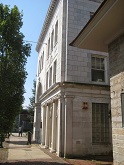 |
Delaware County Historical SocietyFounded in 1895, the Delaware County Historical Society is the oldest historical society in Delaware County, Pennsylvania. Its mission is to acquire, preserve and make available documentation of Delaware County history; to provide and support educational programs on the history of Delaware County; and to publish materials relevant to this history. DCHS operates two buildings: Greenbank Farm in Marple and the 1907 Delaware County National Bank building in Chester, the latter of which houses the Society's research library and museum collections. The Society's archival holdings consist of over 47 collections that span over 1,200 linear feet of materials dating from 1716 to the present, although most of the collections date from the 19th and 20th centuries. While many areas of Delaware Country are represented, the City of Chester is especially well-documented. Original manuscripts, which include ledgers, scrapbooks, correspondence, photographs, deeds, ephemera, maps, and other documents, relate to various people, families, organizations, particularly community associations, businesses, and local government. The collections also include vertical files on various local history topics that mostly consist of secondary-source materials such as newspaper clippings, pamphlets and ephemera, research notes, transcripts, indexes, printed materials, copies of church and civil records, death and funeral records, and census and tax records, with some original materials such as oral histories.
|
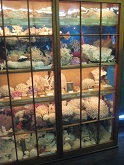 |
Delaware County Institute of ScienceThe Delaware County Institute of Science (Pennsylvania) was organized in 1833 by five friends interested in sciences and natural history. It was formally incorporated in 1836. Over the course of its history, the Institute has served as a forum for amateur and professional scientists to meet for study and discussion, has hosted scientific lectures, and has mounted numerous exhibits of its collections of animals and birds (taxidermy), plants (herbaria), fossils and shells, scientific instruments, and various other objects. The Institute's collections include about 50 linear feet of archival materials, such as organizational records, business records, personal papers, photographs, scrapbooks, blueprints, subject files, maps and atlases, and other materials. Most relate to Delaware County (Pennsylvania), but some items pertain to other locations in Pennsylvania and other states. Although the collections are predominantly 19th century, there is a significant amount of materials from the 18th century and a few items from the 17th century. Of special interest are natural history papers of Graceanna Lewis (1821-1912), the female naturalist, scientific illustrator, and social reformer; a Revolutionary War orderly book from the Valley Forge encampment (1777); a smattering of documents associated with famous historical figures such as John Dickinson and William Penn; and several volumes of original Quaker meeting records.
|
 |
Downingtown Area Historical SocietyFounded in 1978, the mission of the Downingtown Area Historical Society in Chester County, Pennsylvania is to keep local history alive for current and future generations and to promote the rich history of the Downingtown Area. The Society is located in historic Ashbridge House, a structure more than 300 years old. With over 100 linear feet of archival materials dating from the mid 19th century to the present, the Society's holdings include the records of local businesses and men's and women's clubs, as well as family and personal papers, school-related materials, clippings, ephemera, photographs, local history research, and other archival materials.
|
 |
Doylestown Historical SocietyThe Doylestown Historical Society (Bucks County, Pennsylvania) began in 1995 as a committee of the Doylestown Revitalization Board, established by Borough Council to focus on historic preservation. In 2002 it was incorporated as an independent historical society. The Historical Society's archival holdings, located in the Holloway Research Center, date from 1819 to the present and span over 215 linear feet of materials. They include materials such as minutes, ledgers, correspondence, photographs, ephemera, scrapbooks, genealogy records, maps, and blueprints that document local individuals, families, businesses, organizations, and events. Of special interest is the William Edgar Geil papers, 1886-2013 (bulk 1900-1910), which document the once-renowned evangelical missionary and explorer from Doylestown who was most likely the first individual to travel the entire Great Wall of China.
|
 |
Dublin Historical SocietyThe Dublin Historical Society was established in 1990 to preserve and share the history of the Borough of Dublin located in upper Bucks County, Pennsylvania. The Society's archival collection, which dates from the late 19th century to the present and spans approximately 5 linear feet of materials, includes a collection of Dublin Post Office records; stock and employee records of the Dublin Milling Company; and various photographs, ledgers, papers, and ephemera that document Dublin individuals, families, organizations, and businesses.
|
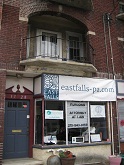 |
East Falls Historical SocietyThe East Falls Historical Society, founded in 2004, is a non-profit organization dedicated to discovering, preserving, and promoting historic interest in the East Falls community. East Falls was originally settled by the Lenni Lenape, a Native American tribe. In 1732 Fort St. David was established as a fishery and the area became popular for this purpose. As the area became industrialized by mills and other enterprises, employee homes developed into a neighborhood of row houses. East Falls is well known for its prominent residents (including actress Grace Kelly) and history of rowing on the Schuylkill River.
The East Falls Historical Society is active in documenting historic buildings and sites in East Falls. It conducts oral history interviews with long-time area residents and directors of local organizations. The archival collections of the Society are comprised of materials relating to the history of East Falls and its prominent residents. Over 25 linear feet of archival materials span from 1897 to 2012.
|
 |
Eastern State PenitentiaryEastern State Penitentiary, a National Historic Landmark constructed by the Commonwealth of Pennsylvania, received its first inmate in 1829. Designed by architect John Haviland, this massive structure epitomizes the Pennsylvania System of imprisonment, a system founded on the concept of rehabilitating criminals through reflection, separate confinement, and education in a trade. Approximately 300 prisons worldwide were based on Haviland's unique design. However, the Pennsylvania System was abandoned in 1913 and Eastern State operated as a congregate prison for 57 more years. In 1970, the Commonwealth sold the penitentiary to the City of Philadelphia, its current owner. After using it for a year, the City abandoned the site with no concrete plans for its reuse. In the 1980s, the City's administration heeded the public's plea for preservation and access, spearheaded by the Eastern State Penitentiary Task Force. The Task Force began tours in 1994 and in 1998 became Eastern State Penitentiary Historic Site, Inc. (an independent nonprofit organization), which leases the building from the City.
Archival materials at ESPHS total approximately 50 linear feet of materials documenting Eastern State Penitentiary specifically and the Pennsylvania System of imprisonment in general. Collections include fragmentary penitentiary records relating to the operations and administration of the prison as a whole, the physical structures and objects within the walls of the penitentiary during its years of operation, and the administrators, staff and inmates who lived and worked within the building. Also included are inmate-produced newsletters, photographs, case files, and oral histories.
|
 |
Eden CemeteryEden Cemetery, located in Collingdale, Delaware County, Pennsylvania, is the oldest African-American owned cemetery in the Unites States. Eden Cemetery was founded in 1902, the collaborative effort of five African American Philadelphians who sought to provide a respectful resting place for African Americans. Eden is the burial ground for many notable 19th century Philadelphia-area African Americans and is on the National Register of Historic Places. The Cemetery's archival holdings encompass about 60 linear feet of materials dating from 1902 to the present. The materials consist of burial and plot registers, financial records, and legal documents that document the interments and lot sales at Eden Cemetery.
|
 |
Elwyn Historical Archives and MuseumElwyn is one of the oldest service organizations for individuals with intellectual disabilities in the United States. Tracing its roots to a Philadelphia school for "mental defectives" founded in 1852, and officially incorporated in 1853 as The Pennsylvania Training School for Feeble-Minded Children, Elwyn has remained at the vanguard in the understanding and support of people with intellectual disability for over 150 years. One of its most influential staff members, Superintendent Dr. Isaac Kerlin, was instrumental in organizing the field's national professional organization, today known as the American Association on Intellectual and Developmental Disabilities. Elwyn maintains its own institutional archives and a small museum dedicated to its history. The Elwyn records, 1852-2006, consist of approximately 125 linear feet of materials from Elwyn's administrative agencies and staff members including records of past superintendents and presidents, student records, materials published by Elwyn including publicity materials, photographs, and various audio and audiovisual materials. The collection is particularly strong in items from the mid-late 19th and early 20th centuries, especially detailed and extensive patient records, administrative records, and photographs. Elwyn also holds about five linear feet of records from the Orphan Society of Philadelphia, the first non-sectarian orphanage in Pennsylvania, which was founded in 1814 and merged into Elwyn in 1965. The Orphan Society of Philadelphia records, 1815-1965 (bulk 1930-1965), consist of administrative and financial records, legal documents, historical files, orphan records, and other materials.
|
 |
Eugenio M. de Hostos Archives at Taller PuertorriqueñoEstablished by Puerto Rican and Latino artists and activists in the North Kensington area of Philadelphia, Pennsylvania in 1974, Taller Puertorriqueño is a community-based cultural organization whose purpose is to preserve, develop, and promote Puerto Rican and Latino arts and culture. Taller Puertorriqueño works to elevate and preserve Puerto Rican and Latino culture through its arts and cultural programs, in the belief that embracing one's cultural heritage is central to community empowerment. The Eugenio M. de Hostos Archives at Taller Puertorriqueño comprises some 100 linear feet of materials dating from circa 1940s to the 2000s, including publications, periodicals, printed matter, and research materials; photographs, slides, VHS cassettes, and audio recordings; and other materials. Of special interest are records from oral history projects conducted by Taller Puertorriqueño and photographs from noted photographer Jack Delano.
|
 |
Fairmount Park Historic Resource ArchivesThe Fairmount Park Historic Resource Archives documents the historic resources of Fairmount Park, a division of the Philadelphia Parks and Recreation (PPR) Department. The Parks and Recreation Department was established in 2010 through the merger of two city agencies: the Fairmount Park Commission, which was created in 1867 to oversee the city's parks, and the Department of Recreation. They document Fairmount Park land, parks, recreational sites, buildings, historic sites, and artifacts, as well as programs and projects related to those resources. The collection includes materials in a variety of formats largely dating from the mid 19th century to the present. Most of the collections consist of maps, blueprints, drawings, and plans that document the Fairmount Park System's architectural and landscape history, in particular, its five watershed parks: Fairmount Park, Wissahickon Valley Park, Cobbs Creek Park, Tacony Creek Park, and Pennypack Park. Notably, the collection also contains hundreds of original architectural and landscape drawings from the 1876 Centennial Exposition that was held in Fairmount Park, as well as a significant amount of photographs, prints, and negatives that document the history of the park system. Reference files, newspaper clippings, scrapbooks, and annual reports offer supporting documentation.
|
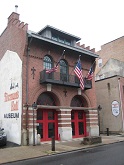 |
Fireman's Hall MuseumThe mission of Fireman's Hall Museum is to preserve the ongoing history of Philadelphia firefighting through the collection, preservation, and presentation of related artifacts for the education of the public and to encourage sound fire prevention practices. Owned by the City of Philadelphia, the Museum is operated by the Philadelphia Fire Department and supported by the Philadelphia Fire Department Historical Corporation. The Philadelphia Fire Department Historical Corporation was chartered in 1974 to support the creation of the museum for the National Bicentennial.
The Fireman's Hall Museum contains over 200 linear feet of archival material, including personal collections of photographs, scrapbooks, and papers from firemen or relating to Philadelphia fires, and records of the Philadelphia Fire Department, the Fire Insurance Patrol of the City of Philadelphia, and other fire-fighting organizations.
|
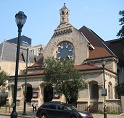 |
First Unitarian Church of Philadelphia ArchivesFirst Unitarian Church of Philadelphia, a Universalist Unitarian congregation, was established in 1796 and is the oldest continually functioning Unitarian church in the United States. The Church's first regularly ordained full-time minister was Reverend William Henry Furness, a well-known religious and abolitionist leader who led the congregation from 1825 to 1875. Since 1885, the congregation has been located in a building designed by Furness's son, the noted architect Frank Furness. The First Unitarian Church of Philadelphia Archives consists of approximately 70 linear feet of archival materials, primarily records from the church, dating from 1796 to the early 2000s. The First Unitarian Church of Philadelphia records include administrative and financial records, church registers, correspondence, history materials, the papers of ministers and others associated with the church, photographs, audio and audiovisual materials, scrapbooks, and newspaper clippings. Of special interest in the collection are papers from William Henry Furness, some of which relate to his involvement in the abolitionist movement.
|
 |
Friends' Central School ArchivesFriends' Central School is a Quaker (Religious Society of Friends), co-educational private school for children in nursery school through 12th grade. The school was established in 1845 in Center City Philadelphia, Pennsylvania and moved to its current location on City Avenue in Wynnewood, Montgomery County, Pennsylvania in 1925. Friends' Central School maintains its own institutional archives with approximately 150 linear feet of records dating from 1785 to the present, with the bulk of the materials dating from 1845 or later. The records document the administration, faculty and staff, students, and alumni of Friends' Central School and include administrative and financial records, enrollment records, personal papers, school publications and ephemera, photographs, scrapbooks, slides, audiovisual materials, objects, and other materials.
|
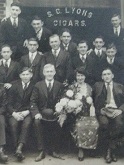 |
Friends of Northeast Philadelphia HistoryFriends of Northeast Philadelphia History (FNEPH) encourages the preservation and promotion of Northeast Philadelphia (Pennsylvania) history by supporting the work of local historians and historical organizations, sponsoring local history activities, and, where appropriate, acquiring historic materials or property relating to Northeast Philadelphia. FNEPH grew out of Friends of Lower Dublin Academy, an organization founded in 2008 to protect the 1798 Lower Dublin Academy school building in the Holmesburg neighborhood. In 2013 the organization changed its name to Friends of Northeast Philadelphia History and broadened its mission to encompass the history of the greater Northeast Philadelphia area. FNEPH maintains about 20 linear feet of archival materials dating from the late 18th century to the present. These include the collections of several local historians, consisting of research materials such as newpaper clippings, articles, photocopies, photographs, and other materials; and a local history manuscript collection containing various primary-source documents such as ledgers, certificates, receipts, deeds, and other family papers and business records. Among FNEPH's strengths is its collection of mostly early 20th century real photo postcards depicting scenes of Northeast Philadelphia.
|
 |
Germantown Historical SocietyFounded in 1901 as the Site and Relic Society, the Germantown Historical Society is an educational and research center dedicated to preserving and interpreting the history of the original German Township in northwest Philadelphia, including the contemporary neighborhoods of Germantown, Mt. Airy, and Chestnut Hill and the Wissahickon Valley. The Society houses a collection of artifacts, books, manuscripts, maps, and images documenting Germantown's many stories.
The archival collections of the Germantown Historical Society total over 625 linear feet of materials dating from 1688 to the present. Holdings include personal papers, manuscripts, business records and institutional archives as well as books, newspapers, church and cemetery records, maps, deeds and other land records, scrapbooks and oral history interviews. The image collection is especially rich and includes thousands of glass plate negatives, daguerreotypes and lantern slides, and well over 5,000 photographs depicting residents, streets and structures from the mid-19th century to the present. Collections of particular note include the archives of the African-American Genealogy Group, the Germantown Theatre Guild, Germantown Hospital and the Philadelphia, Germantown and Norristown Rail Road.
|
 |
Germantown Mennonite Historic TrustGermantown Mennonite Historic Trust was founded in 1947 by the General Conference of the Mennonite Church. It was originally known as the Germantown Mennonite Corporation; the name was changed to Germantown Mennonite Historic Trust in the 1990s. Located in the Germantown neighborhood of Philadelphia, Pennsylvania, the Germantown Mennonite Historic Trust interprets and shares the history, faith and witness of Mennonites in Germantown from 1683 to the present by preserving the historic Meetinghouse and cemetery; maintaining the nearby buildings and grounds; preparing and implementing tours, exhibits, curricula and public programs; and working with Mennonite and Anabaptist churches, conferences and organizations, the Germantown community, and other partners. The Trust's archival holdings encompass about 80 linear feet of materials dating from the 1820s to the 2000s and include financial and administrative records, audio and visual materials, secondary-source research materials, and other documents from or relating to the Germantown Mennonite Historic Trust, as well as papers from individuals and families associated with the Germantown Mennonite Church. There is also a small collection of archival materials relating to the Women's Club of Germantown.
|
 |
Glen Foerd on the DelawareGlen Foerd is the last surviving riverfront estate in the City of Philadelphia. Listed on the National Register of Historic Places, it was built circa 1850 by Charles Macalester, founder of Torresdale and financial adviser to eight U.S. Presidents. In 1893 the estate was acquired by Robert H. Foerderer, a U.S. Congressman and owner of a major Philadelphia leather tanning plant. His daughter, Florence Foerderer Tonner, a noted patron of the arts and collector, lived at Glen Foerd until her death in 1972. Glen Foerd Conservation Corporation now administers the mansion, which houses archival materials relating to the families and organizations that have owned the property over the years as well as a small amount of materials relating to Torresdale history. The archival collections total over 130 linear feet of materials spanning the years 1870 to 2010 (bulk 1985-2004).
|
 |
Goschenhoppen Historians, Inc.The Goschenhoppen Historians, Inc. was founded in 1964 in order to preserve the folk culture of the Goschenhoppen region, one of the oldest continuously existing Pennsylvania German communities in America. The archival holdings of the Goschenhoppen Historians relate to the people, businesses, clubs, churches, crafts, and lifestyle of Pennsylvania Germans and northwestern Montgomery County. The collections comprise over 85 linear feet of ledgers, journals, minute books, newspaper clippings, photographs, scrapbooks, deeds, certificates/Fraktur, and other documents dating from 1720 to the present.
|
 |
Grand Army of the Republic Civil War Museum and LibraryThe Grand Army of the Republic Civil War Museum and Library was established in 1926 as the repository for the collections of the Grand Army of the Republic, Sons of Union Veterans of the Civil War, and other Civil War related organizations. The original Grand Army of the Republic (GAR) was a fraternal organization founded in 1866 for Union veterans of the Civil War. It was succeeded by the Sons of Union Veterans of the Civil War, a similar organization for male descendants of Union veterans.
The Grand Army of the Republic Civil War Museum and Library is located in the Frankford neighborhood of Northeast Philadelphia, Pennsylvania, and houses a large collection of museum artifacts, some 3,000 books, and approximately 300 cubic feet of archives and manuscripts. The archives includes a fairly complete set of records of GAR Post #2 of Philadelphia, along with the records of several dozen other GAR posts, mostly from the Philadelphia area but several from other parts of the nation as well. There are also the records of other Civil War-related organizations, such as the Philadelphia Camp of the Sons of Union Veterans of the Civil War, Daughters of Union Veterans, Ladies of the GAR, and the GAR Home. The collection also includes some 1860s muster out rolls and other original military service records and a significant amount of manuscript material such as letters, diaries, scrapbooks, and photographs in various formats; prints and lithographs; and complete sets of two Philadelphia newspapers during the Civil War years and individual issues of other Civil War-era newspapers.
|
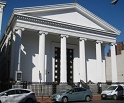 |
Greek American Heritage MuseumThe Greek American Heritage Society of Philadelphia (GAHSP) was established in 2002 by Mary Creticos (1918-2015), a businesswoman who was active in the Greek American community in southeastern Pennsylvania, and her nephew, Peter Christie. Located in the historic Saint George's Greek Orthodox Cathedral in downtown Philadelphia, Pennsylvania, the Society is a volunteer-based organization which strives to preserve and promote Hellenic culture and to reconnect youth and adults to their Greek heritage. As of 2016, GAHSP is in the process of establishing a heritage center, the Greek American Heritage Museum, which will host educational and cultural programs, various exhibits and displays, and collect, display and archive materials that document the history and contributions of the Greek American community in greater Philadelphia. The Greek American Heritage Society's archival collections contain approximately 172 linear feet of materials dating from the 1900s to the present, including the Society's institutional records, photographs, audio and audiovisual materials, materials on Greek churches and organizations in Philadelphia, and the papers of the Creticos family.
|
 |
Harcum College ArchivesHarcum College is a two-year associate degree granting school located in Bryn Mawr, Montgomery County, Pennsylvania. Established by pianist and music educator Edith Hatcher Harcum in 1915, Harcum began as a university preparatory school for women, but added junior college-level classes shortly thereafter and officially became Harcum Junior College in the 1920s. In 1955, Harcum became the first two-year college in Pennsylvania authorized to grant associate degrees. The Harcum College Archives is comprised of some 82 linear feet of materials dating from 1918 to 2016, including administrative records, printed matter and published materials, photographs and audiovisual materials, oversized materials, newspaper clippings, ephemera, and other materials documenting the school and its faculty, students, buildings, curriculum, and activities. There is also a small manuscripts collection consisting of small amounts of photographs, scrapbooks, memorabilia, ephemera, and other materials from various college alumni.
|
 |
Haverford Township Historical SocietyEstablished in 1939, the mission of the Haverford Township Historical Society is to protect, preserve, and promote the history of Haverford Township (in Delaware County, Pennsylvania) and to sustain its cultural heritage for future generations through educational programs, accessible archives, and site preservation. The Society's headquarters is the circa 1800 Nitre Hall, which served as the home of the master of Nitre Hall Powder Mills in the early 19th century. The Society houses nearly 60 linear feet of archival materials dating from 1759 to the present, including family manuscripts, organizational records, photographs, and some secondary-source research material. Items of special interest are: Wilbur Hall photographs, circa 1890-1920, a collection of over 200 glass plate negatives and their corresponding photographic prints documenting suburban trolley transit; the 1864 Civil War diary of Union Soldier Charlie S. Bailey; and the records of several local women's clubs.
|
 |
Haycock Historical SocietyThe Haycock Historical Society (Bucks County, Pennsylvania) was established in 2003 "to research and preserve the history of Haycock and to promote and perpetuate public interest and to inform the public generally of the rich heritage of Haycock Township." Its archival collection is comprised of about 10 linear feet of materials dating from 1846 to the present. In addition to research files of secondary-source materials on local history subjects, the Society's holdings feature a collection of 19th-century school books and store ledgers from a prominent local family.
|
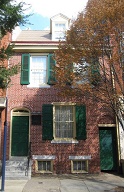 |
The Henry George Birthplace, Archive and Historical Research CenterThe Henry George Birthplace, Archive and Historical Research Center (HGBAHRC) was established in 2013 as a research and educational division of the Henry George School of Social Science. Located in the house in Philadelphia, Pennsylvania that is the birthplace of social and economic philosopher Henry George (1839-1897), the mission of HGBAHRC is three-fold: (1) to promote historical research, publication, and discussion of Henry George and his ideas; (2) to serve as the central repository of archival material on Henry George, the Henry George School of Social Science and the Georgist movement; and, (3) to preserve the Henry George Birthplace as the only surviving residence of Henry George. HGBAHRC's archival collections comprise some 53 linear feet of materials dating from 1857 to 2014, including the Henry George family papers, records of the rehabilitation and restoration of the Henry George Birthplace, materials on anniversary celebrations of important Henry George works, records of the Henry George School of Social Science, and additional materials relating to the single-tax movement and tax reform.
|
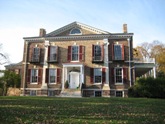 |
Highlands Historical SocietyThe Highlands Historical Society was formed in 1975 to preserve, restore and interpret the historic Highlands mansion and grounds from 1794 to the present. Anthony Morris (1766-1860), a wealthy Philadelphia politician and merchant, purchased over 200 acres of land in Whitemarsh Township, Montgomery County in 1794 and completed construction of The Highlands in 1796. Philadelphia wine merchant George Sheaff (1779-1851) acquired the property in 1813 and it remained in the Sheaff family for over a century. In 1917 the property was sold to Miss Caroline Sinkler (1860-1949), a native South Carolinian with strong ties to Philadelphia. Her niece Emily Sinkler Roosevelt and her husband Nicholas purchased the property in 1941 and gave it to the Commonwealth of Pennsylvania in 1957. The Highlands Historical Society maintains an archival collection documenting the history of the property and the families that lived there. The archival collections total over 15 linear feet of materials spanning the years 1797 to 2005 (bulk 1900-2005).
|
 |
Historic Carversville SocietyThe Historic Carversville Society in Bucks County, Pennsylvania was founded as an all-volunteer non-profit organization in 1971. Its mission is to research and promote the history of the village of Carversville, collect and preserve historical materials relating to Carversville, and to encourage the identification and preservation of historic sites in the area. The Society holds about 10 linear feet of archival materials dating from 1793 to the present, including newspaper clippings, photographs, research files on local history topics and historic buildings, oral history interviews, and two 18th-century deeds.
|
 |
Historic Fallsington, Inc.Historic Fallsington, Inc.'s mission is to "preserve and maintain the historic structures under its stewardship for future generations and educate the public about the culture and history of the village of Fallsington." The village of Fallsington became the first historic district in Bucks County, PA, in 1955 and was placed on the National Register of Historic Places in 1971, largely due to the efforts of Historic Fallsington, Inc. Historic Fallsington is a historic preservation organization and museum that was established in the early 1950s as a response to suburban development that threatened the destruction of historic homes and buildings in the 300 year old village. Since its founding, the organization has continued to work to protect the heritage of Fallsington and in the course of its work has assembled an archives that documents the history of Falls Township and its residents.
Historic Fallsington's archival collection, which spans the years 1729 to 1995 and encompasses about 22 linear feet of materials, includes the papers of numerous Fallsington families and individuals as well as other materials that document the history of the village. The collection includes photographs, personal papers, account books and other financial papers, diaries, deeds, maps, genealogy research, and oral histories.
|
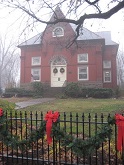 |
Historic Langhorne AssociationThe Historic Langhorne Association, established in 1965, is headquartered in an 1888 building that formerly housed the Langhorne Library. Its goal is to research, record, renovate, and preserve the history of Langhorne, Bucks County, Pennsylvania. The Association offers a research library, a museum of local artifacts, and a collection of archival materials.
Historic Langhorne's archival holdings encompass over 55 linear feet of materials, dating primarily from the mid-19th century to the late-20th century. They include house histories for Langhorne properties, subject files, photographs and postcards, maps and blueprints, family papers, genealogy files, organizational records, the records of local fraternal organizations, newspaper clippings, obituaries, deeds, tax assessments, and other research materials.
|
 |
Historic Sugartown, Inc.Historic Sugartown, Inc. was founded in 1983 to restore the Village of Sugartown located at Sugartown and Boot Roads in Malvern, Chester County, Pennsylvania. Historic Sugartown is "dedicated to the preservation and interpretation of a 19th-century village, to provide an authentic experience of culture and architecture; and to enhance the understanding of our American heritage." The organization stewards nine buildings, a large object collection, and around six linear feet of archival holdings dating from the 1790s to 1980s. The archives document the Worrall and John family, early Sugartown residents who operated a general store and post office, through family papers and business records; as well as various other residents, businesses, organizations, and buildings through scrapbooks, photographs, correspondence, deeds, and other materials.
|
 |
Historic WaynesboroughHistoric Waynesborough is the Chester County, Pennsylvania home of Revolutionary War General Anthony Wayne. Owned by Easttown Township since 1980, the historic site is administered by the Philadelphia Society for the Preservation of Landmarks and supported by many longtime guides and volunteers. Historic Waynesborough's mission is to preserve, display, interpret, and develop the house, collections, and surrounding property as it was during the ownership of seven generations of the Wayne family for the education and enjoyment of the public; and to present to the public the important role which General Anthony Wayne played in our nation's early history. The archival holdings of Historic Waynesborough total approximately 12 linear feet of materials, dating from 1729 to 1990. The collection consists mostly of secondary-source materials, such as newspaper clippings and photocopies, but there is also a significant number of primary documents. Materials pertain largely to various members of the Wayne family and include photographs, financial documents, correspondence, genealogical research, and various other documents.
|
 |
The Historical and Interpretive Collections of The Franklin InstituteFounded in Philadelphia, Pennsylvania, in 1824, in honor of America's first scientist, Benjamin Franklin, The Franklin Institute is one of the oldest and most important science and technology institutes in the nation. The Franklin Institute's mission is to inspire a passion for learning about science and technology. It offers world-class core exhibits, hosts major traveling exhibits, and provides a variety of programming activities that serve a wide range of audiences. As an American Association of Museums-accredited organization, the Institute holds curatorial collections that are considered national treasures. The archives of the Historical and Interpretive Collections of The Franklin Institute comprise some 1,583 linear feet of materials dating from 1683 to the present, including TFI's own institutional records; the papers of leading scientists, inventors, and engineers; and extensive collections of photographs, technical drawings, and graphic arts. Of particular interest are the Wright brothers' documents on aeronautical engineering; records of the Philadelphia Water Department; the original drawings of the Fairmount Water Works by Frederick Graff and his son; papers of early industrialist Oliver Evans; and original books and documents of Benjamin Franklin.
|
 |
Historical Society of Bensalem TownshipThe Historical Society of Bensalem Township (Bucks County, Pennsylvania) was founded in 1977. The Society has published several written histories of the township, actively collects objects and documents relating to the history of Bensalem, and is involved in many special events in the Bensalem area. The Society's archival holdings, which span approximately 60 linear feet of materials and date primarily from the late 19th century to the present, include clippings scrapbooks, subject files, maps, deeds, photographs, ledgers, personal and family papers, and other materials that document Bensalem individuals, families, structures, sites, events, and organizations.
|
 |
Historical Society of the Eastern Pennsylvania Conference of the United Methodist ChurchThe Historical Society of the Eastern Pennsylvania Conference of the United Methodist Church is located at Historic St. George's United Methodist Church in Philadelphia, Pennsylvania. Founded in the 1860s, it is among the oldest societies of its type in the United Methodist Church. The Society works in partnership with the appointed members of the Eastern Pennsylvania Conference Commission on Archives and History to document the Conference's territory, which covers the southeastern quarter of the Commonwealth. This region was host to many of the formative events and founding personalities of the Methodist, Evangelical, and United Brethren Churches, all of which form part of the denominational "family tree" of the United Methodist Church. The Historical Society of the Eastern Pennsylvania Conference of the United Methodist Church holds over 200 linear feet of archival materials in a wide variety of formats dating from the late 18th century to the present. The Society is the repository for records of Eastern Pennsylvania Conference member Methodist and Methodist Episcopal churches when they close, and these closed church records comprise about half of the Society's holdings. The amount of records varies by church, but a substantial quantity of records (over one linear foot of materials) is available for about 50 churches. Approximately 100 more churches are represented by smaller amounts of material. Additionally, the Society holds some records of the Eastern Pennsylvania Conference and records from several preachers' and women's organizations within the Conference. The Society also holds small quantities of papers (less than one linear foot of materials) from various reverends, bishops, and other Methodists, including correspondence, diaries, religious commentary, sermon drafts, pastoral records, autograph books, scrapbooks, marriage certificates, deacons certificates, traveling connections, diplomas, district reports, printed engravings, Methodist historical notes, photographs and photograph albums, and more. Of special interest are documents from John Wesley, Francis Asbury, Thomas Coke, Joseph Pilmore, and Anna Jarvis. The records of St. George's United Methodist Church, 1763 to the present, are also available on-site.
|
 |
Historical Society of Fort WashingtonThe mission of the Historical Society of Fort Washington is "to preserve the history of the Upper Dublin area and above all, to promote the study of history, dealing with our area." HSFW was founded in 1935 and is headquartered in the Clifton House, which stands on a site where Revolutionary Generals are believed to have encamped in 1777. The Society works to preserve the Clifton House, including its invaluable museum and library contents, as well as to stimulate public interest and support for history.
The Historical Society of Fort Washington collects archival materials relating to the Fort Washington area of Montgomery County, PA, including the Borough of Ambler and the Township of Upper Dublin. Its archival holdings consist of ledgers, scrapbooks, photographs, deeds, maps, minute books, and other documents totaling over 30 linear feet of materials dating from 1721 to the present.
|
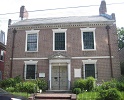 |
Historical Society of FrankfordFounded in 1905 in the Frankford section of Philadelphia, Pennsylvania, the Historical Society of Frankford (HSF) collects, preserves, and presents the history of Northeast Philadelphia and the region. HSF documents and interprets the history of the people, places, events and traditions of the greater Frankford and Northeast Philadelphia area and serves as an advocate for the preservation of the region's historic resources. HSF's headquarters, a Georgian Revival style building built specifically for the Society in 1930, houses its museum and research library and hosts the Society's monthly programs and other activities. HSF's archival collections comprise some 558 linear feet of materials dating from the 1680s to the present, including individual and family papers, business and organizational records, school records, photographic collections, scrapbooks, deeds, maps and atlases, newspapers, and other materials documenting Frankford, Northeast Philadelphia, and the greater Philadelphia area.
|
 |
Historical Society of Hilltown TownshipThe Historical Society of Hilltown Township (Bucks County, Pennsylvania) was established in 1975 to "promote interest in the historical heritage of the township. By preserving buildings, documents and artifacts, and encouraging research, it is hoped to bring the past into perspective." The Society's archival holdings, which encompass over 45 linear feet and date from the late 18th century to the present, consist of various primary-source materials that document Hilltown Township individuals, families, businesses, and properties. These include deeds, personal papers relating to some of the first families of Hilltown, materials relating to area schools, historic site survey forms, photographs, and records of local businesses and organizations. Of special interest is the William Collier slides and files, 1925-1977, that includes 5,200 slides of structures and sites of Bucks County and surrounding areas, local history research files, and professional papers relating to his work for Pennsylvania's Bureau of Employment Security from the 1930s to the 1960s.
|
 |
Historical Society of Montgomery CountyOriginally part of Philadelphia County, Montgomery County is located along the Schuylkill River and became its own county in 1784. Booming industry and manufacturing, rich farm fields, advanced transportation, artistic endeavors and unique religious beliefs, contribute to the greatness of the county. It is the Historical Society of Montgomery County's mission to preserve the county's rich heritage and help tell the stories of the many people who have walked and tended its soil.
The Historical Society of Montgomery County was established in 1881 and incorporated in 1884. It is the designated county historical society as noted by the Commissioners of the County of Montgomery, Pennsylvania. The Historical Society of Montgomery County is a repository for county government records, but also collects private business, organizational, and personal records from the area. The non-county government portion of their archival holdings total about 500 linear feet of materials, spanning from 1690 to 2012.
|
 |
Historical Society of TaconyEstablished in 1990, the Historical Society of Tacony is dedicated to preserving the rich traditions and history of the Tacony section of Philadelphia. Originally a rural community along the Delaware River, Tacony began to be industrialized in the late 19th century when Henry Disston located his saw manufacturing plant there and set about creating an ideal working class community for his employees. Tacony is also significant for being the site of pioneering developments in solar power in the early twentieth century. The Society maintains a collection of historic photographs and documents comprising about 40 linear feet of materials spanning the years 1841 to 2011 (bulk 1900-2011).
|
 |
Historical Society of the Phoenixville AreaFounded in 1977, the mission of the Historical Society of the Phoenixville Area (Chester County, Pennsylvania) is "to identify, collect, preserve, interpret, and disseminate materials and information pertaining to Phoenixville area history in order to assist and educate the public in understanding and appreciating their Phoenixville area heritage and how it relates to their lives." The Society's archival holdings consist of over 175 linear feet of materials covering more than 200 years (from about 1800 to the present, with the bulk of materials dating from 1850 or later). Subject files, photographs, genealogical materials, business and organizational records, scrapbooks, family papers, and other materials document the residents, organizations, businesses, and buildings of the Phoenixville area. Significant holdings include funeral home registers, school attendance lists, church records, Phoenix Iron Company records, Phoenixville Borough records, and records from several local fraternal organizations.
|
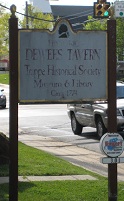 |
The Historical Society of Trappe, Collegeville, Perkiomen ValleyThe Historical Society of Trappe, Collegeville, Perkiomen Valley, Inc., was founded in 1964 as a non-profit educational society to encourage local historical research and publication of the results, promote historical activities in the community, and encourage the preservation of historic sites. The Society operates the Henry Melchior Muhlenberg House and the Andrew Miller - Dewees Tavern Museum in Trappe, Pennsylvania. The Society's archival holdings encompass about 75 linear feet of materials spanning from 1750 to the present.
|
 |
Horsham Preservation and Historical AssociationThe Horsham Preservation and Historical Association (HPHA), founded in 1997, is dedicated to identifying, studying, preserving and protecting the historical heritage, buildings and artifacts of the Horsham area. Horsham Township began as a farming and residential community. For many years, the Willow Grove Naval Air Station was Horsham's largest employer and its most recognized feature. The predecessor of the Air Station was the Pitcairn Airfield, where Harold Pitcairn built the Mailwing airplane, delivered airmail along the East Coast, formed Eastern Air Lines, developed the Autogiro, and entertained celebrities such as Charles Lindbergh and Amelia Earhart.
The Horsham Preservation and Historical Association collects documentary artifacts relating to Horsham Township, the families who occupied the Penrose-Strawbridge property which serves as HPHA's headquarters, and nearby historic Graeme Park. HPHA's archival collections include property records and deeds, correspondence, photographs, family papers, maps, and other document types, comprising about 7 linear feet of materials dating from 1684 to the present.
|
 |
James A. Michener Art Museum ArchivesThe James A. Michener Art Museum, located in Doylestown, Bucks County, Pennsylvania, is dedicated to preserving, interpreting, and exhibiting the art and cultural heritage of the Bucks County region. Opened in 1988, the museum is named for Doylestown's most famous son, the Pulitzer-Prize winning writer James A. Michener. The James A. Michener Art Museum Archives is comprised of some 371 linear feet of materials dating from 1741 to the present (although most materials are twentieth-century), including the papers of local artists, the museum's institutional records, materials on local organizations and individuals, photographs, oral histories, and other materials. Of particular significance are the papers of James A. Michener, noted woodworker and furniture maker George Nakashima, and illustrator and photographer William Arthur Smith.
|
 |
John Bowman Bartram Special Collections LibraryThe John Bowman Bartram Special Collections Library at Bartram's Garden collects materials relating to America's first great botanist, John Bartram (1699-1777), and his descendants. The library is administered by the John Bartram Association, established in 1893 to administer and interpret the Bartram house and the oldest surviving botanic garden in North America. The Library's holdings total nearly 100 linear feet of archival materials, including John Bartram Association records, research on the Bartrams by modern authors, other genealogical research materials, photographs, and original eighteenth- and nineteenth-century manuscripts of Bartram family members.
|
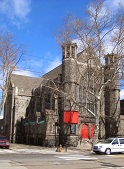 |
John Gloucester Memorial and Historical SocietyThe John Gloucester Memorial and Historical Society was established in 1910 and is dedicated to preserving the history of First African Presbyterian Church. The first black Presbyterian congregation in the United States, First African Presbyterian was established in Philadelphia, Pennsylvania, in 1807 with former slave Rev. John Gloucester as its inaugural pastor. The church is now located at 42nd Street and Girard Avenue in Philadelphia. The John Gloucester Memorial and Historical Society manages approximately 20 linear feet of archival materials dating from 1863 to the present, although the bulk of the materials date from 1950 or later. The collection consists primarily of records of First African Presbyterian Church such as minutes, membership materials, and photographs. There are also some secondary materials about the church, its members, and various organizations and topics that were collected by church members. Of interest are photographs taken by John W. Mosley, a self-taught photographer known for capturing images of Philadelphia's African American community. He worked for the "Philadelphia Inquirer" but also served as official photographer of First African Presbyterian Church.
|
 |
John J. Wilcox Jr. GLBT Archives of PhiladelphiaThe archival collection now known as the John J. Wilcox Jr. GLBT Archives of Philadelphia was originally established in 1976 and has been housed at the William Way Lesbian, Gay, Bisexual and Transgender (LGBT) Community Center since 1997. Dedicated to documenting Philadelphia's LGBT community, the collection consists of books, periodicals, organizational records, personal papers, ephemera, visual materials, and sound recordings concerning sexual minorities, the gay/lesbian rights movement, and the history of sexual minority communities with an emphasis on Philadelphia and the Delaware Valley. There are also materials on the women's movement of the 1950s to 1970s. The archival materials total nearly 300 linear feet of materials from 1918 to the present (most are from 1960 to the present).
|
 |
John James Audubon Center at Mill GroveMill Grove is the first home in America of John James Audubon and the only true Audubon home still standing in the United States. Located in Lower Providence Township, Montgomery County, Pennsylvania, Mill Grove was owned for over 17 years by Audubon's father, Jean, a French sea captain. His son John James Audubon lived on the estate from 1803 to 1806. Father and son divested themselves of Mill Grove by 1808. In 1813 Samuel Wetherill of Philadelphia purchased the property. Aside from a break between 1876 -1892, Mill Grove remained in the Wetherill family until Herbert J. Wetherill sold it in 1951 to Montgomery County. The County established the site as a nature sanctuary and a museum about John James Audubon. In 2003 Montgomery County and the National Audubon Society entered into a public/private partnership for Mill Grove. Now named "The John James Audubon Center at Mill Grove," this Montgomery County owned historic site is under the daily management/operation of the National Audubon Society.
The archival collections at the John James Audubon Center at Mill Grove include materials relating to John James Audubon and his family, the Wetherill family, Mill Grove site history, the National Audubon Society, and bird watching. The holdings total approximately 26 linear feet of materials dating from 1726 to 2002.
|
 |
Johnson House Historic SiteThe Johnson House is a National Historic Landmark in the Germantown neighborhood of Philadelphia, Pennsylvania, significant for its association with the Underground Railroad and abolitionism. Johnson House Historic Site, Inc. is a non-profit organization dedicated to "preserving, interpreting, collecting, researching, and studying historic material relating to the site; providing educational services to diverse audiences through tours, programs, outreach publications, and special events; and working closely with the community on program service development." The Johnson House Historic Site's archival holdings span several linear feet and date from 1794 to the end of the 20th century. Significant holdings relate to former occupants of the house: the Johnson family, a Quaker family of staunch abolitionists; and the Woman's Club of Germantown, which owned the house from 1917-1982 and participated in the social, civic, educational and philanthropic life of Germantown.
|
 |
Kennett Township Historical CommissionThe Historical Commission of Kennett Township, Chester County, Pennsylvania is appointed by the Township Supervisors to collect, study, and disseminate the history of the Township. The Kennett Township Historical Commission holds about 23 linear feet of archival materials dating from the mid 19th century to the present. Nearly half of the Commission's total holdings are subject files focusing on people, places, organizations, buildings, and events of Kennett Township. The subject files are comprised mainly of secondary-source materials, such as clippings, pamphlets/ephemera, and family genealogies, as well as a small amount of primary-source materials. Another one-third of the Commission's holdings are property research files containing materials compiled during two historic resource surveys in the township. Additionally, the Commission has small collections of oral history recordings, Township records, and papers from the Hannum family.
|
 |
King of Prussia Historical SocietyThe King of Prussia Historical Society was first established in 1953; after a period of dormancy, it was revived in April 2012. The aim of the Society is to share the history of Upper Merion Township, Montgomery County, Pennsylvania, and to preserve its richness for future generations. The Society's archival holdings measure about 10 linear feet of materials dating from the late 18th century to the present. Included are newspaper clippings, research files, pamphlets and ephemera, scrapbooks, ledgers, indentures, oral histories, photographs, and various other items documenting the area's residents, buildings, businesses, student sports clubs, and various other organizations.
|
 |
Lansdale Historical SocietyThe Lansdale Historical Society, founded in 1972, works to preserve and share collections that document the history of the Borough of Lansdale and the greater North Penn area of Montgomery County, Pennsylvania. The complex where the Historical Society is headquartered includes the Jenkins Homestead, a 1770-era Federalist-style farmstead that is the oldest building within the original borders of Lansdale.
Although some materials in Lansdale's collection (specifically deeds) predate the Borough's founding in 1872, the majority of its archival holdings, which span over 160 linear feet, date from the late 19th century to the present. These include photographs, negatives, slides, the records of businesses and fraternal organizations, tax assessments, family histories, obituaries, and various other materials relating to local history. The centerpiece of the collection is its newspaper holdings, including 133 years of the "Lansdale (North Penn) Reporter."
|
 |
Laurel Hill CemeteryFounded in 1836 by John Jay Smith in what is now the East Falls neighborhood of Philadelphia, Pennsylvania, Laurel Hill Cemetery is one of the first rural cemeteries to be established in the United States and one of only a few cemeteries to be designated a National Historic Landmark. Numerous prominent figures, locally and nationally, are interred at Laurel Hill Cemetery including Henry Disston, Harry Kalas, David Rittenhouse, Matthew Baldwin, and Frank Furness, as well as members of the Widener, Elkins, Wistar, and Wharton families. The archival holdings of Laurel Hill Cemetery consist of 525 linear feet of materials dating from 1836 to the present. Included are minute books, legal documents, administrative records, financial records, photographs, ephemera, and other records documenting Laurel Hill Cemetery. Of special interest are the burial cards with corresponding lot books and interment records that document the sale of lots and burials at the cemetery.
|
 |
Limerick Township Historical SocietyThe Limerick Township Historical Society was founded in April 1984 by the former Limerick Township Bicentennial Committee. The Society's headquarters is in the 1827 Hunsberger House, which is listed on the National Register of Historic Places. The mission of the Limerick Township Historical Society is to preserve the history, lore, and historical heritage of Limerick Township and to provide a repository for township memorabilia, such as deeds, pictures, genealogies, historical papers, documents, books, artifacts, and other areas of Township tradition. The Society's archival collections include some 80 linear feet of materials dating from the late 18th century to the present.
|
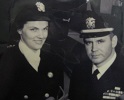 |
Lower Makefield Historical SocietyThe mission of the Lower Makefield Historical Society (Bucks County, Pennsylvania) is to stimulate an appreciation of the beauty and historic significance of Lower Makefield Township; to promote, research and publish findings regarding local history and culture; to establish a historical library and collections of artifacts; and to foster an interest in and encourage the preservation of historic buildings, sites, and landscapes in Lower Makefield and the greater Bucks County area. The Society's archival holdings span about 10 linear feet of materials, consisting principally of: research files on the Township compiled by Ralph N. Thompson; oral histories, house histories, and scrapbooks; and records of the Joseph Heacock Company, a nusery and dairy farm (1887-1930). The Society's oldest document is a 1729 deed; the most recent archival items date from the early 21st century. The Society also holds published books and objects, including a wooden model of the Octagonal School House once located in the township.
|
 |
Lower Merion Historical SocietyThe Lower Merion Historical Society is dedicated to "Preserving Our Past for the Future" through stewardship of local history, education of the community, preservation of historic resources, and outreach to promote awareness of the cultural heritage of the Township of Lower Merion and the Borough of Narberth.
Since 1949 our volunteers have been a vital force preserving the rich history of the Lower Merion community, assembling more than two dozen well-indexed collections for research in our 1812 building and on the web. These collections include 18th century diaries and family histories; binders of printed photographs of our mansions, factories, stores, houses and people; books detailing local history; burial records; clippings from newspapers and other sources; digital photographs of current buildings and their predecessors; histories of the notable industrialists and industries that have been prominent in the Township; Main Line maps and real estate atlases; Narbrook Park, a "City Beautifu;l" negatives by newspaper photographers and researchers; public school board meeting minutes back to the 1830s, high school yearbooks, school sports and other records; soldiers' letters from World War II; transcribed tapes of oral history and ephemera from Lenape arrowheads to school desks. The collections are indexed on the web at http://lowermerionhistory.org, where most items can be viewed at any time.
|
 |
Lower Pottsgrove Historical SocietyThe Lower Pottsgrove Historical Society in Montgomery County, PA, was founded in 1985 to provide opportunities for area residents to explore their heritage; to conduct programs, projects and activities to help further the preservation of the community; to investigate the history, and keep a library of important memorabilia of the community; and to assist in the restoration and maintenance of historic buildings in Lower Pottsgrove Township. LPHS archival holdings total over 10 linear feet of newspaper clippings, original and copy photographs, ephemera, materials on local schools, Sanatoga Park, Sanatoga Speedway, Ringing Rocks Park, and the records of a local tax collector (1934-1942).
|
 |
Malvern Historical CommissionMalvern Historical Commission in Malvern, Chester County, Pennsylvania, was established in 1983 by ordinance of the Malvern Borough Council to locate, name, and preserve for posterity the significant architectural, natural, and other historic sites within the Borough of Malvern. In addition to maintaining the records of its own activities, the Commission serves as a general repository of local history materials. The Malvern Historical Commission's archival holdings total approximately 80 linear feet of materials dating from 1873 to 2016, including historic property files, subject files, oral histories, manuscript materials, and the personal papers of individuals and institutional records of local organizations.
|
 |
Margaret R. Grundy Memorial LibraryThe Margaret R. Grundy Memorial Library, located along the banks of the Delaware River in the Borough of Bristol, PA, "strives to inform, empower and enrich lives by providing free and equal access to ideas and information with a knowledgeable staff in a welcoming and inspiring environment."
In addition to its circulating collection, the Grundy Library maintains an archive of local history and borough municipal records spanning over 110 linear feet. The library archive documents the history of Bristol Borough, Bucks County, and the surrounding areas primarily from the 19th century to the present. Relating to local individuals, families, businesses, and organizations, the collection is particularly strong in documenting Bristol's prominent role in the history of Bucks County. The municipal records collection includes an impressive amount of borough records, including council minutes that begin in 1730, ten years after the borough's incorporation.
|
 |
Marple Historical SocietyThe Marple Historical Society in Marple Township, Delaware County, Pennsylvania was founded in 1960. Its mission is to preserve and protect the historical heritage of Marple Township and provide information to the community with regard to that heritage. The Society holds about 10 linear feet of archival materials dating from 1685 to the present, including original deeds and indentures, business ledgers, and photographs. The bulk of the Society's archival holdings, however, are secondary-source materials such as family genealogies, historical articles, and research scrapbooks from a local historian.
|
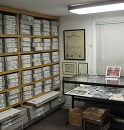 |
Media Historic Archives CommissionThe Media Historic Archives Commission, a unit of the Borough of Media, Delaware County, Pennsylvania, was established in 1981 to act as custodian for archival materials relating to the Borough and its vicinity. The Commission holds over 100 linear feet of archival materials, including photographs, slides, movie film, newspaper articles, audio tapes, historic notes, and memorabilia. The Commission also owns some artifacts and archeological findings. The oldest documents date from the 1680s, although most materials date from the mid 19th century to the present.
|
 |
Mikveh Israel ArchivesCongregation Mikveh Israel, known as the "Synagogue of the American Revolution," is the oldest formal Jewish congregation in Philadelphia, Pennsylvania and the oldest continuous synagogue in the United States, tracing its origins to a communal cemetery established for Jews in Philadelphia in 1740. Following the Sephardic tradition, Mikveh Israel has counted among its members many prominent individuals who have contributed to the development of Jewish life in Philadelphia and the United States. The archival holdings of Mikveh Israel consist of 120 linear feet of materials dating from 1765 to 2011. Included are a large quantity of membership and vital records and extensive papers from several former religious leaders and synagogue presidents, as well as administrative and financial records, photographs, publications, and ephemera. Many prominent Jews affiliated with Mikveh Israel, individuals of renown in the local Philadelphia as well as national or international Jewish communities, are documented in the collection, including Rebecca Gratz (1791-1869) and other members of the Gratz family, Rev. Isaac Leeser (1806-1923), Moses Aaron Dropsie (1821-1905), Rev. Sabato Morais (1823-1897), Judge Moyer Sulzberger (1843-1923), Dr. Solomon Solis Cohen (1857-1948), Cyrus Adler (1863-1940), Rev. Leon Haim Elmaleh (1873-1972), and Dr. A.S.W. Rosenbach (1876-1952).
|
 |
Mill at Anselma Preservation and Educational TrustThe Mill at Anselma, built in Chester Springs, Pennsylvania in 1747, is the most intact, authentic example of a custom water-powered grain mill in the United States. The Mill at Anselma Preservation and Educational Trust was established in 1998 to "create an innovative historical attraction at the Mill at Anselma that demonstrates through sensory experiences, the evolution of technology and the impact of change in commerce, free enterprise, and transportation on American life over three centuries for schoolchildren, families, scholars, visitors and local residents." The Trust houses approximately 10 linear feet of archival materials dating from 1844 to the present, including a collection of primary and secondary-source materials, such as ledgers, oral histories, photographs, blueprints of the mill and surrounding property, newspaper clippings, and subject files relating to the history of the mill and the families that ran it, and the office files of Eleanor Morris, the co-founder and former president of the French and Pickering Creeks Conservation Trust and a founding member of the Mill at Anselma Preservation and Educational Trust.
|
 |
Millbrook SocietyThe Millbrook Society is a non-profit organization whose mission is historic preservation, education, historical research, historic re-enacting, and archaeology. The Society was founded in 1984, with an emphasis on local history relating to the Borough of Hatboro area and Montgomery and Bucks Counties. The Millbrook Society archival collections encompass approximately 150 linear feet of materials spanning 1739 to 2011 (bulk 1900 to 2011).
|
 |
Montgomery Township Historical SocietyFounded in 1988, the mission of the Montgomery Township Historical Society is to educate people about, and encourage an enthusiastic appreciation of, the history and heritage of the North Penn area with a special focus on Montgomery Township; to promote conservation and preservation of private and public buildings and resources; and to advocate for the use of those resources so as to maintain or enrich the cultural landscape of our community. The Society holds approximately 30 linear feet of archival materials relating to the people, schools, historic properties, and local history of Montgomery Township, Pennsylvania.
|
 |
Moore Archives at Historic Yellow SpringsThe Moore Archives at Historic Yellow Springs preserves and provides access to documentary evidence of the history of the village of Yellow Springs, an historic property in northern Chester County, Pennsylvania. Yellow Springs was the site of 18th and 19th century spas; the first military hospital in North America, built during the Revolutionary War; an orphan school for children of Civil War Soldiers; the Pennsylvania Academy of the Fine Arts (PAFA)'s Country School; Good News Productions, the film studio that created the 1958 movie, "The Blob"; and Chester Springs Studio, a vibrant arts center that merged with Historic Yellow Springs in 2007. The Moore Archives holds about 150 linear feet of archival materials, dating from 1823 to 2013, which document the site's history from 1722 into the 21st century. The materials are a combination of original records and collected secondary-source materials about the several organizations that have occupied the village of Historic Yellow Springs over its storied history.
|
 |
Morris Arboretum ArchivesThe educational institution and historic public garden that is now the Morris Arboretum of the University of Pennsylvania was previously the private estate of Quaker siblings John Thompson Morris (1847-1915) and Lydia Thompson Morris (1849-1932). Bequeathed to the University of Pennsylvania in 1933, it was part of the University's Botany Department until it was established as a separate Interdisciplinary Resource Center in 1975. The Morris Arboretum is the official Arboretum of the Commonwealth of Pennsylvania.
The Morris Arboretum Archives was established in 1987. The collection is comprised of approximately 105 linear feet of materials such as photographs, instructional slides, correspondence, maps and drawings, administrative and financial papers, press clippings and ephemera, and other materials that document the history of the Arboretum from the time John and Lydia Morris acquired it as a private estate in 1887 until the present.
|
 |
Museum of the American RevolutionThe Museum of the American Revolution, which is scheduled to open in Philadelphia, Pennsylvania in 2017, focuses on the history of the rebellion of the North American colonies against British rule that resulted in the formation of the United States of America. The Museum's archival collection is comprised of about 10 linear feet of materials dating from circa 1730-1977. The collection includes a wide range of manuscripts and other paper materials that document the War, its aftereffects, the evolution of revolutionary ideas, the lives of America's Founding Fathers and everyday soldiers, and commemorations of Revolutionary War sites (especially Valley Forge, Pa.).
|
 |
Mummers MuseumThe Mummers Museum is dedicated to the Philadelphia New Year's Day tradition known as the Mummers Parade. The roots of the tradition date back centuries, but the first official parade occurred on New Year's Day 1901 and continues annually. The museum, which opened in 1976, houses a rich collection of Mummers' paraphernalia and memorabilia, including spectacular costumes, a few of which date to the turn of the 20th Century.
The archival collections at the Mummers Museum comprise about 250 linear feet of materials which span from 1899 to present.
|
 |
National Iron & Steel Heritage MuseumThe National Iron & Steel Heritage Museum is a project of the Graystone Museum Society of Coatesville (Chester County, Pa.), which was incorporated in 1984. The mission of the National Iron & Steel Heritage Museum is "to promote an understanding of the iron and steel history of Coatesville, Chester County, Southeastern Pennsylvania and the region to audiences of all ages and interests by collecting, preserving, exhibiting and interpreting iron and steelB!B/s history and its relationship to the region and nation beyond." The vast majority of the museum's 900 linear feet of archival holdings are records of two Coatesville companies: Lukens Steel Company and G. O. Carlson, Inc. The Museum also holds technical drawings from Phoenix Iron Company; a large collection of artwork and reference materials from Klaus Grutzka, a commerical artist who specialized in industrial scenery; and a small collection of photographs, original documents, and other materials relating to Coatesville local history. Most of the Museum's archival materials date from the 20th century, with some dating to the mid 19th century.
|
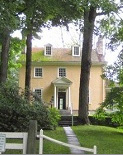 |
Nether Providence Historical SocietyThe Nether Providence Historical Society was founded in 1987 with a mission to research and preserve the history of Nether Providence Township, Delaware County, Pennsylvania, and present that history to the community. Based in the 1785 Thomas Leiper House, the Society holds 10 linear feet of archival materials dating from 1825 to the present relating to township residents, events, buildings, and organizations. Included are newspaper clippings, pamphlets and other printed materials, family genealogies, photographs, maps and blueprints, deeds and certificates, diaries, ledgers, and other materials. The Society is also the repository of the records of the Nether Providence Council of Republican Women.
|
 |
New Hope Historical SocietyThe New Hope Historical Society, located in the Borough of New Hope, Bucks County, PA, was organized in 1958. Its mission is to "inspire people to explore New Hope's past, understand its present, and envision a better future." In 1966 the Society located to the historic Parry Mansion in downtown New Hope, along the banks of the Delaware River. The Society's holdings include about 20 linear feet of archival materials, consisting of photographs, letters, family papers, minute books, organizational records, oral history recordings, and other documents relating to the people, properties, businesses, and organizations of New Hope. Prominent local families the Parrys and Coryells are well-represented in the collection.
|
 |
New London Area Historical SocietyThe New London Area Historical Society was established in 1971 and is dedicated to preserving and enhancing understanding of the history of New London, New Britain, and Franklin Townships in Chester County, Pennsylvania. In addition to hosting quarterly lectures and meetings, the Society also has an archival collection consisting of twelve linear feet of materials, dating from 1711 to 2000 (bulk 1970-2000). The collection is a mix of primary and secondary-source materials relating to the history and residents of New London Township and includes manuscripts, property files, photographs, slides, newspaper clippings, subject files, and other materials. Of special interest is a 1767 indenture and a military appointment document from 1776.
|
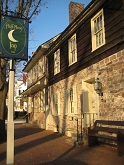 |
Newtown Historic AssociationThe Newtown Historic Association, Inc. was incorporated in 1964 as an organization dedicated to the preservation of the heritage of Newtown, Bucks County, PA. Its mission is "to stimulate interest in, preserve, celebrate and share the historical heritage of both Newtown Borough and Township." The Association's archival collection, which dates from circa 1800 to the present and spans close to 200 linear feet of materials, documents the history of Newtown Borough and Township and the surrounding area, including local individuals, families, businesses, and organizations. Documents and artifacts from renowned late eighteenth/early nineteenth-century artist Edward Hicks and his family form part of the Association's holdings.
|
 |
Newtown Square Historical SocietyThe main purposes of the Newtown Square Historical Society are to protect, preserve, and promote the historic resources of Newtown Township, Delaware County, Pennsylvania, and the crossroads community known as Newtown Square, and to tell its story to its residents, children, and adults. The formation of the Society in 1984 resulted from the efforts of several Newtown Square residents who coordinated celebrations for the township's tricentennial in 1981. Newtown Square Historical Society's archival holdings comprise approximately 14 linear feet of materials dating from 1744 to the present. The materials include various original manuscripts, such as ledgers, photographs, letters, deeds, pamphlets, ephemera, maps, and newspaper clippings, as well as secondary-source materials and digital files that document the individuals, families, organizations, and landscape of Newtown Square.
|
 |
Old Eagle SchoolOld Eagle School is an 18th-century schoolhouse located in the community of Strafford, Pennsylvania, part of Tredyffrin Township, Chester County. Initially, donated by Jacob Sharraden, a German Lutheran, for 'religious and educational purposes,' the land also includes burial grounds with the remains of Revolutionary War soldiers. In 1895 title to the property was granted to a local group of trustees, who continue to manage it. In addition to the schoolhouse, which dates to 1788, the property also includes some seventy graves, including those of early settlers of the area as well as Revolutionary War soldiers who died during the Continental Army's encampment in nearby Valley Forge in 1777-1778. Old Eagle School is now largely used for community events. The Trustees of Old Eagle School records consist of eight linear feet of materials dating from 1865 to the 2000s (bulk 1920s-1990s), including correspondence, deeds, minutes, financial records, and property materials, as well as histories of the school, newspaper clippings and research materials relating to the school, photographs, and other materials.
|
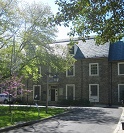 |
Old York Road Historical SocietyThe Old York Road Historical Society was founded in 1936 to study and preserve the history and folklore of the communities along and adjacent to Old York Road from Philadelphia to New Hope, Pennsylvania. The Society's collections are particularly focused on the communities in eastern Montgomery County, Pennsylvania, including the townships of Abington, Cheltenham, Lower Moreland and Upper Moreland, and the boroughs of Bryn Athyn, Hatboro, Jenkintown, and Rockledge. The society presents historical lectures, publishes scholarly papers in the form of a bulletin, and maintains library and archival collections of area history. The Old York Road Historical Society archival collections comprise some 550 linear feet of materials dating from the seventeenth century to the present, including personal papers of families and individuals; records of local businesses, organizations, and institutions; collections of photographs, deeds, maps and atlases, scrapbooks, and ephemera; real estate records; historic property inventories; school records; subject files and other materials.
|
 |
Pearl S. Buck InternationalThe Pearl S. Buck Foundation was established in 1964 by American author and humanitarian, Pearl S. Buck (1892-1973). Originally headquartered at a residence purchased by Buck on Delancey Place in Philadelphia, Pennsylvania, the organization re-located to Buck's Green Hills Farm property, in Perkasie, Bucks County, in 1967. The Foundation aimed to provide support to children in Asian countries who were not eligible for adoption. In 1991, the Foundation merged with Welcome House, another charitable organization founded by Buck, and in 1999, the Foundation changed its name to Pearl S. Buck International (PSBI). As of 2015, Pearl S. Buck International provides opportunities to explore and appreciate other cultures, builds better lives for children around the globe and promotes the legacy of our founder by preserving and interpreting her National Historic Landmark home. The archival holdings of Pearl S. Buck International consist of slightly more than 130 linear feet of archival materials, dating from 1860 to 2005. They include photographs from Pearl S. Buck International, a grouping of small collections containing papers of various missionaries working in China in the early 20th century, letters between Buck and friends, including Mary Carolyn Dobbs, a teacher and pioneer in the field of special education, as well as the papers of Pearl S. Buck and her second husband and publishing partner, Richard Walsh. Of special interest, the Pearl S. Buck and Richard J. Walsh papers consist of materials that document the literary, philanthropic and business endeavors of Buck and Walsh from circa 1890 to 1972, representing Buck's home office files, the editorial files of Asia Magazine during Walsh's time as editor, the files of the East and West Association, some papers from Chinese author, Lin Yutang, and other materials.
|
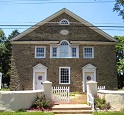 |
Pennepack Baptist Historical FoundationPennepack Baptist Church, established in 1688 in what is now Northeast Philadelphia, Pennsylvania, is the oldest existing Baptist church in the state and one of the oldest in the nation. Pennepack Baptist Historical Foundation was established in 2010 to preserve the Church and promote its history. The Foundation maintains an archives of approximately five linear feet of archival materials, including church records such as administrative volumes, cemetery deed certificates, legal papers, and late nineteenth and early twentieth century photographs; scrapbooks compiled by church historians consisting of photocopied, printed, and some original documents dating from 1844 to the present; and newspaper clippings, genealogy and other materials. The church's earliest records are on deposit at the American Baptist Historical Society (Atlanta, GA).
|
 |
Pennypacker MillsPennypacker Mills, the home of former Pennsylvania Governor Samuel W. Pennypacker (1843-1916), contains an extensive archival collection that documents his term as governor (1903-1907), including construction of the State Capitol, and reflects his interests in Pennsylvania history, family history, and Pennsylvania German culture. The archival and library collection dates from 1568-1980, with the majority of materials from 1830-1916.
Pennypacker Mills contains furnishings and artwork collected by Samuel W. Pennypacker and is open regularly for tours. Activities throughout the year include exhibits, nature walks, workshops, and special events.
|
 |
Perkasie Historical SocietyThe Perkasie Historical Society, founded in 1954, strives to preserve the history of Perkasie Borough, located approximately 40 miles north of Philadelphia in Bucks County, Pennsylvania. This volunteer organization is headquartered in the Perkasie Museum, which was originally a Lehigh Valley Transit Trolley Station (from 1912 to 1951). The Society cares for three other historic sites along with the Museum: the South Perkasie Covered Bridge, the Perkasie Carousel, and the Stout Family Cemetery. Perkasie's archival holdings, which span about 40 linear feet of materials, date primarily from the late 19th century to the present. They include photographs, personal and family papers, the records of businesses and organizations such as the local American Legion post and the First National Bank of Perkasie, and materials relating to World War I and World War II.
|
 |
Philadelphia Clef Club of Jazz and Performing ArtsThe Philadelphia Clef Club of Jazz and the Performing Arts was established in 1966 as the social arm of Local No. 274, the Philadelphia Black musicians union, which was in existence from 1935 to 1971. As part of its mission to further the level of arts and culture in the community, the Clef Club strives to preserve and promote jazz and its history through educational and cultural services and programs. The Clef Club's archives are comprised of the records of both Local No. 274 and the Clef Club, totaling some 34 linear feet of materials dating from 1925-1974. Included are meeting minutes, administrative and financial records, membership/artists' files, correspondence, and a small amount of photos and ephemera. With such illustrious Local No. 274 members as Dizzy Gillespie, John Coltrane, Benny Golson, the Heath Brothers, Jimmy Smith, Grover Washington, and others, the Clef Club's archives are an important historical resource documenting Philadelphia's world-famous jazz tradition.
|
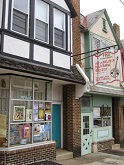 |
Philadelphia Folksong SocietyThe Philadelphia Folksong Society was established in 1957 by a small group of folk artists and enthusiasts in Philadelphia, PA for the purpose of gathering folk and traditional musicians for performances in small, informal settings throughout the year. Since 1962, the Society has hosted the annual Philadelphia Folk Festival, a multi-day event that is the longest continuously-running folk festival in the United States. In addition to the Folk Festival, the Society is dedicated to preserving the past, promoting the present, and securing the future of folk music and related forms of expression through education, presentation, and participation. The Society's archival holdings encompass 130 linear feet of materials documenting the history of the Society from its inception in 1957 to present. The records include some organizational records but consist primarily of audio and audiovisual recordings and paper records, photographs, clippings, programs, and ephemera documenting every year of the Philadelphia Folk Festival since its inception, as well as other Philadelphia Folksong Society events.
|
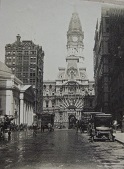 |
Philadelphia History MuseumThe Philadelphia History Museum at the Atwater Kent engages visitors with its extraordinary collections that reflect Philadelphia's rich history and the diversity of its people and their neighborhoods through exhibitions, educational programs, and technology which explore the past to better understand the present. Founded in 1938 and opened to the public in 1941, the Museum is located in a Center City Philadelphia building that was designed by famed architect John Haviland and occupied by the Franklin Institute from 1826 to 1933. It was originally called the Atwater Kent Museum, named for the inventor and radio pioneer A. Atwater Kent, who purchased the historic building and gave it to the City of Philadelphia. In 2010, during a major renovation that closed the Museum from 2009 to 2012, the Museum was re-named The Philadelphia History Museum at the Atwater Kent.
The Philadelphia History Museum holds more than 100,000 objects and over 300 linear feet of archival materials dating from 1682 to the present. A large proportion of the archival holdings are photographic materials, such as glass plate negatives, lantern slides, film negatives, cartes des visite, and other formats in addition to paper prints. There are also scrapbooks, diaries, ledgers, pamphlets, postcards, flyers, drawings, and other papers, records, and ephemera from people, families, businesses, and organizations associated with Philadelphia.
|
 |
Philadelphia Sketch ClubPhiladelphia Sketch Club, America's oldest continuously-operating club for artists, was founded in 1860 by six students of the Pennsylvania Academy of the Fine Arts (PAFA) in Philadelphia, Pennsylvania. Since its founding, the Club has offered art classes, mounted exhibitions, and given artists the opportunity to socialize and network with each other. The Archives of the Philadelphia Sketch Club total about 75 linear feet of materials dating from the Club's founding in 1860 through the present. Included are individual artists' files with correspondence, as well as exhibition catalogues, scrapbooks, photographs, newspaper articles, minute books, the newsletter "Portfolio," and financial records. A highlight of the archives is "Seventy-Five Years of the Philadelphia Sketch Club," the club history of over 1,000 pages that was compiled in 1936.
|
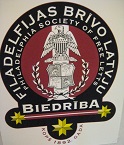 |
Philadelphia Society of Free LettsThe Philadelphia Society of Free Letts, or Filadelfijas brīvo Latvju Biedrība (BLB), is the oldest Latvian Society outside of Latvia. Established as a settlement house in 1892 by Lettlanders fleeing oppression in Tsarist Russia, over time the organization has served as a community center, advocate for Latvian independence, and research facility for promoting Latvian culture. The BLB maintains a bilingual Latvian-English library as well as approximately 40 linear feet of archival materials dating from 1894 to 2014. Largely consisting of the administrative, financial, and membership records of the BLB, these archival holdings additionally include ephemera and documents relating to the BLB and Latvian culture that were donated or collected from other sources.
|
 |
Plumstead Historical SocietyThe Plumstead Historical Society was founded in 1999 with the mission to discover, collect, observe, advance, and disseminate knowledge of the history of Plumstead Township, Bucks County, Pennsylvania. The Society's holdings, which consist of approximately 10 linear feet of materials dating from 1809 to the present, include primary source documents such as school records, deeds, correspondence, business ledgers, and oral histories. There are also secondary source materials including newspaper clippings, photocopies of original documents, narrative histories, and printed materials. A large portion of the Society's collections is school records, mostly school attendance registers, with some supporting documents from the Plumstead Township School Board and its successor, the Central Bucks Joint School Board.
|
 |
Plymouth Meeting Historical SocietyPlymouth Meeting Historical Society is a non-profit charitable organization dedicated to preserving the history of Plymouth and Whitemarsh Townships in Montgomery County, Pennsylvania. Organized in 1952, the Society gained stature when it succeeded in saving the Village of Plymouth Meeting from the threat of the proposed Blue Route Expressway. Through the efforts of the Society, the Village of Plymouth Meeting was placed on the National Register of Historic Districts in 1971. The adjacent Village of Cold Point was added to the Register in 1982 and became a further protection against highway expansion. The archival collections of the Society total over 40 linear feet of materials dating primarily from the mid-19th century to the late-20th century, including photographs, maps, architectural drawings, family papers, scrapbooks, deeds, tax assessments, ephemera, and research materials that document the history of this historic area of Montgomery County, Pennsylvania.
|
 |
Pottsgrove ManorPottsgrove Manor is a historic house built in 1752 for John Potts, ironmaster and founder of Pottstown, Pennsylvania. It is owned and administered by Montgomery County. A successful ironmaster and merchant, John Potts was appointed Justice of the Peace and Judge of the Philadelphia County Court of Common Pleas. He was elected to the Pennsylvania General Assembly from both Berks and Philadelphia Counties. The archival collections at Pottsgrove Manor are comprised of materials relating to the Potts family and their property in Pottstown. The collections total 2 linear feet of materials dating from 1720 to circa 1905.
|
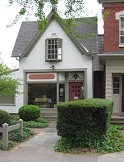 |
Pottstown Historical SocietyThe Pottstown Historical Society was organized in 1936 by a direct descendant of John Potts, founder of Pottstown in Montgomery County, PA. The object of the organization is to gather and preserve records and historical landmarks for the community. Collections relate to Pottstown and Montgomery County history and include papers and records relating to the Potts and Rutter families and their iron furnaces; local newspapers; church and cemetery records; census records; city directories; yearbooks; photographs; oral histories; histories of Montgomery, Berks, and Chester Counties; and other materials. The Pottstown Historical Society's archival holdings comprise about 125 linear feet of materials dating from 1715 to the present.
|
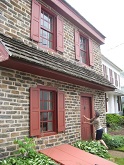 |
Quakertown Historical SocietyThe mission of the Quakertown Historical Society in Bucks County, Pennsylvania is "to preserve, collect and document the history of Quakertown for future generations to come." The Society maintains a complex of three buildings: the Burgess Foulke House, a stone structure built in 1812 by the father of Quakertown's first burgess (mayor); the Market Place Museum, a renovated barn from the late 1800s; and Liberty Hall, near the site where the Liberty Bell rested in Quakertown in 1777 on its way to Allentown. The Quakertown Historical Society holds approximately 60 linear feet of archival materials dating from 1767 to the present, including local business and municipal ledgers, photographs, newpaper clippings, scrapbooks, deeds, and various other documents.
|
 |
Radnor Historical SocietyThe Radnor Historical Society, located in the historic Finley House in Wayne (Delaware County) PA, was established in 1947 to preserve, protect, present, and promote the history of Radnor Township. The society's archival collections comprise approximately 150 linear feet of materials, dating from 1702 to the present, including business records, school records, family papers, subject files, glass plate negatives, maps, and the records of a variety of local clubs and associations. The majority of collections materials are stored on-site, but some items are on long-term loan to other institutions including the Athenaeum of Philadelphia.
|
 |
Radnor Hunt ArchivesRadnor Hunt, founded in 1883 in Radnor, Pennsylvania, a suburb of Philadelphia, is the oldest continuously active fox hunt in the United States, as recognized by the Masters of Foxhounds Association of America. The Hunt remained in Radnor until 1931, when encroaching development in the area led it to move to a new location near Malvern, Pennsylvania. Since its founding Radnor Hunt has been a focal point of an active sporting community, carrying on traditional fox chasing as well as other activities involving horses, hounds, countryside pursuits, and sportsmanship. The Radnor Hunt Archives is comprised of 56 linear feet of materials dating from 1886 to the present, including records generated or received by the Hunt in the course of its activities and personal papers and other materials pertaining to the Hunt, fox hunting, and relevant subjects.
|
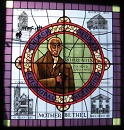 |
Richard Allen Museum ArchivesMother Bethel African Methodist Episcopal Church was established in Philadelphia in 1794 by Richard Allen (1760-1830), a former slave who in 1786 began preaching at special services for African Americans at a white Methodist church. After leaving that congregation following an incident of racial discrimination, Allen purchased a plot of land at 6th and Lombard Streets. In the early 1790s he established what would eventually become Bethel Church on the site. The church was officially dedicated on July 29, 1794. In 1816 Bethel and other black Methodist congregations united to form the African Methodist Episcopal Church in America, with Allen serving as its first bishop and Bethel Church becoming "Mother Bethel," the mother church of the denomination. As of 2016, Mother Bethel remains a prominent African Methodist Episcopal congregation, the founding church of the world-wide AME denomination. Its current church building, the fourth on the site, sits on the land originally purchased by Richard Allen, the oldest parcel of real estate in the United States continuously owned by African-Americans. The records of Mother Bethel African Methodist Episcopal Church total some 50 linear feet of materials dating from 1816 to 2016, including administrative and financial records, baptism and marriage certificates, records and papers from organizations and people associated with Mother Bethel and its activities, church publications, African Methodist Episcopal Church conference records, funeral programs, photographs, audio, and audiovisual materials, scrapbooks and memorabilia, anniversary celebrations materials; and other records.
|
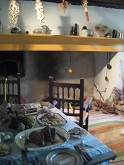 |
Richard Wall House MuseumThe Richard Wall House Museum is located in Elkins Park, Montgomery County, Pennsylvania. Richard Wall bought the land directly from William Penn and built a house on the property in 1682. Later, it would become a stop along the Underground Railroad. It is the house with the longest continuous family residency in the state of Pennsylvania (1682-1979). The Richard Wall House Museum is now under the auspices of the Cheltenham Township Historical Commission. Its archival holdings span approximately 20 linear feet and date from the mid-nineteenth to the twenty-first century, consisting of newspaper clippings, research notes, several different photographic types, scrapbooks, maps, ephemera, and a small amount of family papers. The collection documents the people, buildings, and organizations of Cheltenham Township and nearby areas.
|
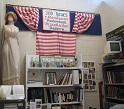 |
Roxborough Manayunk Wissahickon Historical SocietyThe Roxborough Manayunk Wissahickon Historical Society is the successor of two local organizations: the 21st Ward Community Council's Historic Committee, formed in 1967 to save one of the oldest structures in the area, and the Wissahickon Valley Historical Society, formed in 1926 (not related to the present organization of the same name located in Blue Bell, Montgomery County). The purpose of the Society is to discover and collect any material which may help to establish or illustrate the history of the area; its exploration, settlement, development, and activities in peace and war; and its progress in population, wealth, education, arts, science, agriculture manufactures, trade, and transportation.
The Society's archival holdings, located at the Roxborough branch of the Philadelphia Free Library, date primarily from the mid-19th century to the present and total about 15 linear feet of materials. The collection consists primarily of newspaper clippings, articles, unpublished genealogies, copies of primary-source documents, and other secondary-source materials relating to local history. The collection also includes a small amount of original primary-source materials, such as receipts and invoices, correspondence, photographs, meeting minutes, deeds, and ephemera.
|
 |
Ryerss Museum and LibraryRyerss Museum and Library, owned and operated by Philadelphia's Park & Recreation Department, is a public lending library and museum located in the Burholme neighborhood of Northeast Philadelphia. The 1859 building that houses the museum and library was originally owned by two generations of the Ryerss family, Joseph Waln Ryerss and his son Robert Waln Ryerss. Joseph Ryerss (1803-1868) earned his living as an importer/exporter, and served as President of the Tiaga Railroad and the Philadelphia Exchange. The Ryerss family were related both by blood and by marriage to the prominent Philadelphia Quaker Waln family who descended from original Pennsylvania settler Nicholas Waln. Robert Waln Ryerss (1831-1896) was a lawyer who scandalized Philadelphia society by marrying his housekeeper, Mary Ann Reed, eight months before his death. After his death, Robert's will provided for the creation of a museum, library and park. Robert's widow, Mary Ann, spent the rest of her life traveling the world to collect items to add to the family's collection for what is now the Ryerss Museum.
Ryerss Museum and Library's archival holdings are comprised of Ryerss and Waln family papers and other documents relating to the the development of the museum. The collections total over 10 linear feet of materials dating from 1758 to 1950.
|
 |
Sellersville MuseumThe Sellersville Historical and Achievement Authority was created circa 1974 to organize a centennial celebration of the 1874 incorporation of the Bucks County, Pennsylvania Borough of Sellersville. The Authority is responsible for the operation of the Sellersville Museum, an 1875 two-story school building that, in addition to regular and special exhibition rooms, holds 35.5 linear feet of archival materials dating from 1770 to the present. Among the significant materials in the museum's archival collections pertaining to local organizations, businesses, and people of Sellersville are those of: Grand View Hospital, the first hospital in the county; U.S. Gauge, a notable manufacturer of measuring instruments that at one time was the largest area employer; Walter Emerson Baum, a prominent artist of the Pennsylvania Impressionist school; and Dr. Clyde R. Flory, a physician active in World Wars I and II.
|
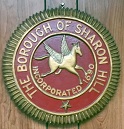 |
Sharon Hill Historical SocietyThe Sharon Hill Historical Society in Delaware County, Pennsylvania was incorporated in 1991 by a group of citizens who wished to protect the historic railroad station on Sharon Avenue in the Borough of Sharon Hill from demolition. The restoration of this railroad station remains a priority of the organization, which also collects materials relating to and promotes the history of the area. The Society's archival holdings encompass about 15 linear feet of materials which date from 1879 to the present. Secondary-source materials such as clippings, computer print-outs, and copies of original documents form the bulk of the collection, but there is also a significant amount of original, primary-source materials including photographs, deeds, and sewer rent ledgers for the Borough of Sharon Hill (1959-1982).
|
 |
Solebury Township Historical SocietyThe Solebury Township Historical Society was incorporated in 1981 as a non-profit organization dedicated to the preservation and interpretation of Solebury Township's (Bucks County, Pennsylvania) historical heritage. The Society, which is headquartered in an historic one-room schoolhouse located in Solebury Village, has an archival collection that spans over 45 linear feet of materials dating from 1845 to the present. The bulk of the society's holdings is local historian Edwin (Ned) Harrington's extensive collection of private publications and research files on various local history topics, particularly local families and historic properties. The Historical Society also has a large collection of attendance registers and some financial records from Solebury schools (1865-1969), records of the Solebury Farmers Club (founded in 1871), and a collection of oral histories which include local personalities and a number of artists from the Pennsylvania Impressionist School.
|
 |
Southampton Baptist CorporationSouthampton Baptist Church, also known as Old School Meetinghouse, in Southampton, Bucks County, Pennsylvania, is the oldest Baptist Church in Bucks County. The Church traces its roots to a group that split from the Religious Society of Friends (Quakers) in the 1690s. From circa 1702 to 1746 Southampton Baptist was part of Lower Dublin (Pennepack) Baptist Church in the Bustleton section of Philadelphia. It became independent from Lower Dublin Baptist in 1746. Southampton Baptist Church grew in the eighteenth and nineteenth centuries, but membership declined in the twentieth century. No longer an active congregation, the Church is owned and managed by the Board of Trustees of the Southampton Baptist Corporation. The Southampton Baptist Corporation Archives consist of approximately 15 linear feet of materials dating from 1746 to 2013, including church records and personal papers of church members.
|
 |
Springfield Township Historical Society (Bucks County, Pa.)The Springfield Township Historical Society (Bucks County, Pa.) was founded in 1980 and incorporated as a non-profit in 1984 to "enrich the lives of the residents of Springfield Township by assisting them in researching the history of their homes and families; and to promote and encourage the interest and preservation of the history of the township." Located in a renovated 1892 one-room school house, the Society's archival holdings comprise approximately 20 linear feet of materials dating from 1789 to the present. Materials relating to various township residents and organizations include original photographs, manuscripts, family papers and business records, deeds, and oral histories. There are also genealogy and subject files with newspaper clippings, research notes, and narrative histories.
|
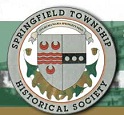 |
Springfield Township Historical Society (Montgomery County, Pa.)The Springfield Township Historical Society was organized in 1985 with the purpose of researching and preserving the history of Springfield Township, Montgomery County, Pennsylvania, and educating the general public as to this history. STHS collections include numerous photographs of Springfield Township sites, a small amount of Colonial-era tax records, research on the history of various residences and institutions, and atlases and maps from the late 19th through the 20th century. The collection also contains a number of deeds and documents relating to Springfield Township properties, as well as extensive holdings of information, photographs, and artifacts from the Stotesbury estate, Whitemarsh Hall. STHS archival holdings total about 40 linear feet of materials dating from 1740 to the present.
|
 |
Spring-Ford Area Historical SocietyThe Spring-Ford Area Historical Society was founded in 1984. Its mission is to promote and develop information of historical value for the people of Spring City (Chester County, Pa.) and Royersford (Montgomery County, Pa.). The Spring-Ford Area Historical Society Museum complex, located at the William Lewin Plantation House dating from 1861, offers a research library and houses displays on local industry and culture.
The Society's archival collections, which total over 80 linear feet of materials dating primarily from the late 19th century to the late 20th century, consist of photographs, negatives, postcards, scrapbooks, deeds, family histories, obituaries and funeral records, court dockets, business records, ephemera, and other research materials.
|
 |
St. David's Episcopal Church Parish ArchivesSt. David's Episcopal Church in Wayne, Radnor Township, Delaware County, Pennsylvania traces its origins to 1700 and is, as of 2016, the largest of the 157 parishes in the Episcopal Diocese of Pennsylvania. The original church building, constructed in 1715, is still extant on the property and continues to be used as a place of worship today. Now over three hundred years old, St. David's congregation continues to expand and remains committed to continuing worship and maintaining and increasing its education activities and outreach ministries. The St. David's Episcopal Church Parish Archives is responsible for collecting, preserving, and making accessible archival materials created by or related to the Church and its congregation. The Parish Archives' archival holdings consist of approximately 50 linear feet of materials dating from 1678 to the present and include administrative and financial records; materials relating to the church building and other structures on the property, the church grounds, and cemetery; various types of photographic, audio, and audiovisual materials; scrapbooks and other materials from St. David's church groups; published and printed matter relating to St. David's and other nearby organizations; research materials about the history of the Church, as well as the people and organizations associated with it; and other materials.
|
 |
St. James' Community History CenterSt. James' Community History Center was created to preserve and recover the history of St. James' Episcopal Church in Lower Providence Township, Montgomery County, Pennsylvania (also known as: St. James' Episcopal Church, Collegeville; St. James' Church, Perkiomen; and St. James', Evansburg) and its surrounding environs. The Center is dedicated to the preservation of artifacts and documents and the conversion of historical documents to appropriate formats to ensure their preservation and facilitate access. The Center's archival holdings total about 10 linear feet of materials, including church administration records, member lists and vital records, genealogical and local history research materials, photographs, and a small amount of rectors' papers.
|
 |
St. Peter's Episcopal ChurchSt. Peter's Episcopal Church in Philadelphia, Pennsylvania was established in 1758 as a "chapel of ease" of nearby Christ Church, the first Anglican church in Philadelphia. St. Peter's became an independent entity in 1832. St. Peter's church building held its first service in 1761 and has been in continuous use since that time. It was designed by well-known architects Robert Smith and William Strickland; sculptor William Rush contributed to its interior. Many prominent Philadelphians have been associated with the church, including artist Charles Willson Peale and US Vice President George Mifflin Dallas, both of whom are buried in its graveyard. St. Peter's maintains its post-1832 records, as well as a few items from the late 18th and early 19th centuries, in an on-site archives. St. Peter's original records pre-dating 1832 are stored at Christ Church, but a full set of handwritten copies of records from 1761 to 1832 are available at St. Peter's. Included in the St. Peter's Archives are minutes of the vestry, parish registers and records of service, accounting and financial records, deeds, blueprints, photographs, sound recordings, and other records of the Church. In addition, there are materials from parish organizations and affiliated organizations.
|
 |
StentonStenton was the country estate of James Logan (1674-1751), who immigrated to Philadelphia with William Penn in 1699 as Colonial Secretary. Logan remained the Penn family's representative and agent in Pennsylvania for the duration of his life and served at the center of the colony's political life. Between 1723 and 1730 he built Stenton, a fine early Georgian gentleman's house in the countryside near Philadelphia (now lower Germantown). Stenton still stands and is an historic site administered by The National Society of The Colonial Dames of America in the Commonwealth of Pennsylvania since 1899. Stenton houses about 10 linear feet of original archival papers from the Logan family and descendants,1700 to 1932, and approximately 50 linear feet of documents relating to the administration of Stenton, including research on the family, site maintenance records, and administrative records of the Colonial Dames, 1898-2013.
|
 |
Strawberry MansionStrawberry Mansion is a historic house museum in Fairmount Park, Philadelphia. Once known as "Summerville," the house was built in 1789 and expanded with additions in the 1820s. It was sold to the Fairmount Park Commission in 1867, but it was not until 1926 that a unified committee of interested women, The Committee of 1926, formed to act as the stewards of the house and restore it to its former glory. The Committee of 1926 continues to administer Strawberry Mansion, which stands as the largest of the Fairmount Park historic houses.
Strawberry Mansion is the repository for records of the Committee of 1926 and the Pennsylvania Society of New England Women. It also holds collections of the Women's Committee of the Philadelphia Sesqui-Centennial International Exposition of 1926 and of eighteenth century Pennsylvania Surveyor-General John Lukens. The archival holdings total over 35 linear feet of materials dating from 1763.
|
 |
Sunrise MillSunrise Mill dates to 1767 when Michael Krause constructed the grist mill. The archival collection relates to Dr. Chevalier Jackson, who owned the property from 1918-1958. Dr. Jackson advanced the field of laryngology with the invention of the bronchoscope. Many of his tools were invented in the mill itself. Dr. Jackson was also instrumental in getting Congress to pass the Federal Caustic Poison Act of 1927.
Sunrise Mill is currently closed to the public, but the Dr. Chevalier Jackson papers are open to researchers by appointment.
|
 |
Thornbury Historical SocietyThe Thornbury Historical Society was founded in 1976 during the nation's bicentennial to preserve and promote the history of Thornbury Township, Delaware County, Pennsylvania. Its archival holdings, totaling about 10 linear feet of materials dating from the late 19th century to the present, document people, places, organizations, and other topics relating to Thornbury Township and nearby areas. In addition to secondary-source materials such as newspaper clippings, ephemera, and narrative historical essays, the collection includes small amounts of primary-source documents such as World War I letters, Thornbury School District records, video footage for a documentary on the township's history, and records of a local restaurant.
|
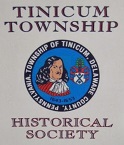 |
Tinicum Township Historical SocietyThe Tinicum Township Historical Society in Delaware County, Pennsylvania was organized in 1986 to collect, maintain, interpret, and make available items of historic importance to the township and the community. The Society's archival holdings comprise about 25 linear feet of materials dating from 1791 to 2013, including photographs, architectural drawings, maps, ephemera, newspaper clippings, and photocopies of primary- and secondary-source documents focusing on local history topics. The Society also holds about 20 linear feet of records from a township commissioner, 1982-2007.
|
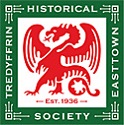 |
Tredyffrin Easttown Historical SocietyFounded in 1936, the Tredyffrin Easttown Historical Society is the oldest community organization on the Upper Main Line in suburban Philadelphia conducting local historical research and collecting local historical resources pertaining to the townships of Tredyffrin and Easttown in eastern Chester County, Pennsylvania. Continuously since 1937 the Society has published Tredyffrin Easttown History Quarterly, a periodical focused on Upper Main Line history. The Society holds over 35 linear feet of archival materials dating from 1732 to the present, such as photographs, glass plate negatives, genealogy and local history research materials, school records, correspondence, minute books, financial records, and other family papers and organizational records.
|
 |
Tri-County Heritage SocietyThe mission of the Tri-County Heritage Society is to collect, preserve and disseminate the history that relates to the people, properties and events of Berks, Chester and Lancaster Counties in Pennsylvania. The Tri-County region is the area in southeastern Pennsylvania where southern Berks, northern Chester, and eastern Lancaster counties meet. The Tri-County Heritage Society was established in 1970 as the Morgantown/Caernarvon Historical Society, with a focus specifically on the Caernarvon Township-Morgantown area. The society later expanded its geographic area to the broader Tri-County region and in 1990 was re-incorporated as the Tri-County Heritage Society. The archival holdings of the Tri-County Heritage Society comprise some 289 linear feet of materials dating from 1735 to 2016, including individual and family papers, the records of local businesses and organizations, township tax records, and subject files and local history materials.
|
 |
Tyler ArboretumTyler Arboretum, one of the oldest and largest arboreta in the northeastern United States, is a 650-acre public garden in Media, Delaware County, Pennsylvania. It was established in 1944 through a bequest of Laura Hoopes Tyler, a descendent of the property's original owner, Thomas Minshall. The Minshall family grounds became an arboretum in the early 19th century when brothers Minshall and Jacob Painter began amassing a collection of over 1,000 ornamental plants for scientific study. The Arboretum has approximately 18 linear feet of archival materials dating from 1681 to the present, which include personal and financial papers from the Tyler, Painter, and Minshall families who lived on the property for eight generations, as well as administrative records, correspondence, financial papers, historical research, and other materials relating to Tyler Arboretum. Of interest are a 1681 William Penn deed to Thomas Minshall, several 19th century family photograph albums, and the files of Dr. John Caspar Wister (1887-1982), who was the first director of Tyler Arboretum from 1946 to 1968 and is considered to be one of the premier horticulturalists of the 20th century. Today, Tyler Arboretum's mission is to preserve, develop, and share its diverse horticultural, historic, and natural site resources in order to stimulate stewardship and an understanding of our living world.
|
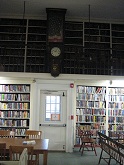 |
Union Library of HatboroIn existence since 1755, the Union Library of Hatboro is the third oldest library in Pennsylvania and the second oldest to be operating under the original charter. In addition to an extensive collection of antiquarian books and institutional records dating from the mid eighteenth century, its archival holdings include ledgers, scrapbooks, minute books, photographs, newspaper clippings, and other documents dating from 1755 to the present. The Union Library of Hatboro also has collected archival documents relating to the history of Hatboro. The entire collection totals over 20 linear feet of materials.
|
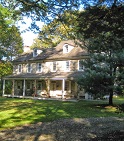 |
Upper Darby Historical SocietyThe Upper Darby Historical Society was founded in 1984 for the purpose of preserving historic sites, documents, monuments, and artifacts in Upper Darby Township, Delaware County, Pennsylvania. The Society holds about 60 linear feet of archival materials, one-third of which consists of a set of approximately 1,000 early 1900s glass plate negatives from a local photographer. The remainder of the Society's archival holdings consist of various primary and secondary source materials dating from 1799 to 2013 that document Upper Darby families, individuals, organizations, institutions, and events over time. The primary source materials include maps, scrapbooks, deeds, photographs, slides, ephemera, correspondence, autograph books, and more; the secondary source materials include newspaper clippings, photocopies of original documents, narrative histories, research notes, and printed works.
|
 |
Upper Moreland Historical AssociationSince its founding in 1996, the role of the Upper Moreland Historical Association in the community has been the collection, preservation and stewardship of the history, folklore, and culture of Upper Moreland Township (Montgomery County, PA). The mission of the Association is to foster an appreciation for local history, to promote an interest in the area's past events, people and unique cultures, and to instill a sense of pride in the heritage of our community. The Association houses over 50 linear feet of archival materials, including newspaper clippings, ephemera, pamphlets/brochures, original and reproduction photographs, photocopies of primary source documents, research notes and genealogies, oral histories, scrapbooks, ledgers, and deeds.
|
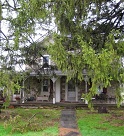 |
Upper Uwchlan Township Historic CommissionThe Upper Uwchlan Township Historic Commission was established in 1989 to help preserve the history and historic structures of the Chester County, Pennsylvania township. The Historic Commission maintains a collection of approximately 17 linear feet of archival materials dating from 1829 to 2005, including manuscripts from local families as well as secondary-source subject files relating to the people, buildings, property, organizations, and other aspects of Upper Uwchlan Township. The property files are a particularly convenient resource for local property researchers or home owners. Also of special interest are papers from prominent local educator Abraham Fetters, Jr., including some Civil War documents and items pertaining to local schools, including the Edgefield Institute (a private co-ed academy run by Abraham Fetters Jr. out of his home, 1868-1884).
|
 |
Uwchlan Township Historical CommissionUwchlan Township Historical Commission (Chester County, Pennsylvania) was founded in 1975 in conjuction with the US Bicentennial celebration to promote historic preservation within the township. The Commission holds open hours in two township-owned historic buildings, the John Cadwalader House and the Edith P. Moore School House; researches buildings in the township built before 1950, especially those in the Lionville Historic District; and works generally to promote the history and preservation of Uwchlan Township. The Commission holds over 60 linear feet of archival materials dating from 1742 to the present. Over half of these materials are research and subject files on historic properties and other local history topics, consisting of secondary-source materials such as newspaper clippings, published and unpublished research articles, photocopies of primary-source documents, and pamphlets and ephemera. There is also a substantial amount of original primary-source material, such as photographs, deeds, maps, family papers, business records, municipal records, and various other materials collected from local people and organizations.
|
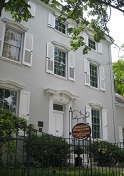 |
Village Improvement Association of DoylestownThe Village Improvement Association (VIA) was founded in 1895 by a group of women in Doylestown, Bucks County, Pennsylvania, with the goal "to promote every proper means of improving and beautifying Bucks County." The VIA founded Doylestown Hospital in 1923 and is currently headquartered at the James-Lorah Memorial Home, an historic home the VIA maintains which was left to the organization by one of its founding members after her passing. The VIA has a membership of over 350 women and continues to undertake projects relating to health care, welfare, community improvement, education, and the arts in Bucks County. The VIA's archival holdings consist of roughly 40 linear feet of materials dating from 1833 to the present and include materials documenting the Village Improvement Association of Doylestown, as well as the James and Lorah families, who were the previous residents of the organization's headquarters.
|
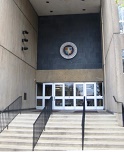 |
Villiger Archives of St. Joseph's Preparatory SchoolSt. Joseph's Preparatory School is a Roman Catholic high school for boys in Philadelphia, Pennsylvania that was founded by Jesuit priests in 1851. Originally established as a preparatory school for St. Joseph's College (now University), it moved to its present location in North Philadelphia in 1868. As of 2016, St. Joseph's Preparatory School enrolls just under 1,000 students. It also manages the Church of the Gesu, a large Cathedralesque Roman Catholic church adjacent to the school that was completed in 1888 and served as home of the Gesu Parish of the Archdiocese of Philadelphia until 1993. The Villiger Archives of St. Joseph's Preparatory School holds some 325 linear feet of materials dating from circa 1730 to 2016 (bulk 1890s-2016), including school records, materials relating to the Church of the Gesu and Gesu Parish, and materials documenting Jesuits in North Philadelphia.
|
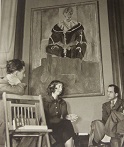 |
Violette de Mazia FoundationThe mission of the Violette de Mazia Foundation is to teach and advance the aesthetic theories and experiential educational methods of art appreciation developed by John Dewey, Albert C. Barnes, and Violette de Mazia. The Foundation was established in 1991, soon after the death of Violette de Mazia (1896-1988) and is located in Wayne, Delaware County, Pennsylvania. Ms. de Mazia had a long association with The Barnes Foundation, which was founded by Albert Barnes in Merion (Montgomery County, Pennsylvania) in 1922 to B!B0promote the advancement of education and the appreciation of the fine arts and horticulture.B!B1 She served as director of education and vice president of the board of directors and was the driving force behind its art education program for over sixty years. The Violette de Mazia Foundation holds about 50 linear feet of papers from Ms. de Mazia dating from 1891 to 2013. These consist primarily of materials relating to Ms. de Mazia's work at the Barnes Foundation as a teacher, director of education, and a trustee. There is also a small amount of her personal papers in the collection. Original documents from Jacques Lipchitz, John Dewey, William Glackens, and other prominent artists and intellectuals can be found in the de Mazia papers.
|
 |
Wallace Township ArchivesEstablished in 1975 by the township commissioners, the Wallace Township Historical Commission (Chester County, Pennsylvania) is charged with the responsibility of researching and recording the township's heritage. As custodian of this heritage, the Commission endeavors to preserve the historical integrity of the Township and maintain archives relating to the people, buildings, industries, landscape, and other pertinent information. The Archivist of Wallace Township is a position created by township ordinance and appointed by the Board of Supervisors to care for and grow the archival collection. The Wallace Township Archives is comprised of about 50 linear feet of archival materials dating from the late 1800s to the present, including scrapbooks, maps and blueprints, deeds, financial and administrative records, photographs, audio recordings, ephemera, correspondence, posters, and genealogy and property research materials. The Archives is also the repository for the Abraham R. McIlvaine correspondence, 1836-1857, on long term loan from the Friends of Springton Manor. McIlvaine (1804-1863) was a farmer and United States Congressman from Pennsylvania. In office from 1843-1849, he befriended future president Abraham Lincoln during Lincoln's only term in Congress.
|
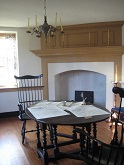 |
Warwick Township Historical SocietyThe business and purpose of the Warwick Township Historical Society (WTHS) is to bring together those people interested in history, and especially in the history of Warwick Township, Bucks County, Pennsylvania. WTHS is responsible for restoring, maintaining and operating the Moland House property, a Revolutionary War historic site where Pulaski and Lafayette joined Washington's army, for the benefit of the public. WTHS archival holdings include materials regarding the late 1990s and early 2000s restoration of the Moland House, organizational records of the WTHS and its predecessor (the Warwick Township Historic Commission), and a 1989 historic resource survey of Warwick Township.
|
 |
WelkinweirWelkinweir is an historic 162-acre estate, arboretum, and nature sanctuary in East Nantmeal Township, Chester County, Pennsylvania. The property, which in the early 18th century was part of Reading Furnace, was purchased in 1935 by Everett G. (1902-1983) and Grace H. (1905-1999) Rodebaugh, philanthropists, conservationists, and socialites. Everett owned a prominent court reporting business. Welkinweir is owned and administered by Green Valleys Watershed Association, an environmental organization the Rodebaughs helped found in 1964. It was placed on the National Register of Historic Places in 2001.
Welkinweir is the repository of the Everett and Grace Rodebaugh papers, circa 1890-1985, which consist of approximately 25 linear feet of materials containing Everett Rodebaugh's professional papers, which include correspondence and legal/court records and transcripts; the personal papers of Everett and Grace, which largely include photographs, travel slides, and letters between the two; and materials relating to the Welkinweir estate such as photographs, correspondence, financial and legal documents, and blueprints. Welkinweir also holds the Estelle Cremers collection on Welkinweir, circa 1975-2001 (bulk 1990-2001), a small accumulation of materials compiled by Estelle Cremers in her role as executrix for the estate of Grace Rodebaugh and historian of Welkinweir.
|
 |
Welsh Valley Preservation SocietyThe mission of the Welsh Valley Preservation Society is to educate the public about the history of Towamencin Township and its place in Pennsylvania history as demonstrated by the architecture of the Morgan Log House, the lives of its past residents and their material culture. The circa mid-1700s Morgan Log House, on land originally settled in 1708 by Daniel Boone's grandfather Edward Morgan, is an example of early domestic architecture. Originally founded as the Towamencin Historical Society in 1970, the Society changed its name to the Welsh Valley Preservation Society in 1985, in response to a need to expand its educational programming.
The Welsh Valley Preservation Society collects archival material relating to Towamencin Township in general and to the Morgan Log House in particular. The repository holds approximately 3 linear feet of archival material dating from 1795 to 1998, including photographs, scrapbooks, and deeds.
|
 |
West Caln Township Historical CommissionThe West Caln Township Historical Commission collects archival materials and performs research on the history of West Caln Township in Chester County, Pennsylvania. The Commission's archival holdings include over 10 linear feet of materials dating from the mid-19th century to the present, consisting mostly of secondary-source materials such as newspaper clippings, photocopies, and research notes, with some original documents including school board records, maps, photographs, letters, oral histories, and deeds. The holdings document various West Caln Township individuals, families, organizations, and properties.
|
 |
West Nantmeal Township Historical CommissionThe West Nantmeal Township Historical Commission was established in 1998 by local residents who wanted to preserve the history of West Nantmeal Township in Elverson, Chester County, Pennsylvania. The mission of the West Nantmeal Historical Commission is to gather and maintain historical records for the township, identify historical structures and encourage their preservation and restoration, and promote a community awareness and appreciation for the historical nature of the township. The Commission's archival holdings encompass six linear feet of materials dating from 1759 to the present. The collection consists of a mix of primary and secondary-source materials relating to West Nantmeal Township and includes manuscripts, subject files, oral histories, photographs, maps, and other materials.
|
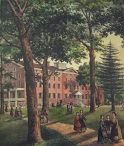 |
Westtown School ArchivesWesttown School in Westtown Township, Chester County, Pennsylvania is the oldest continuously operating coeducational boarding school in the United States. It was founded by the Philadelphia Yearly Meeting of the Religious Society of Friends (Quakers) in 1799 with the goal of educating Quaker children in an environment that fostered moral development consistent with their religious ideals. The Esther Duke Archives at Westtown School, named in honor of Westtown alumna Esther Duke (1920-2005), contains over 650 linear feet of archival materials that date from 1682 to the present. Westtown school records make up the vast majority of the Archives' holdings, measuring approximately 600 linear feet. The Archives holds significant correspondence from the 19th century between students and families, as well as smaller collections from various alumni, teachers, and other individuals associated with Westtown, documenting teaching careers, school experiences, and lives spent beyond the school. Because of Westtown's strong Quaker heritage, the Archives is a resource for Quaker history as well as the history of education and related topics.
|
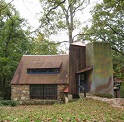 |
Wharton Esherick MuseumThe Wharton Esherick Museum is a non-profit organization founded in 1971 to preserve and exhibit Wharton Esherick's unique, self-designed and self-furnished studio/home in Malvern, Chester County, Pennsylvania. Wharton Esherick (1887-1970) was a sculptor who worked primarily in wood, readily extending his unique forms to furniture, furnishings, utensils, interiors and buildings, creating sculptural environments. He has been called the link between the Arts and Crafts Movement and the resurgent interest in furniture making following World War II, the dean of American craftsmen, and the foundation of the current Studio Furniture Movement. The Wharton Esherick Museum holds about 10 linear feet of papers of Wharton Esherick and his immediate family, including photographs, work documentation, correspondence, financial papers, publicity clippings, and other materials that primarily document Esherick's work and to a lesser extent his personal life and the personal life of his immediate family. The Museum also holds a smaller collection of research files on Esherick compiled by Susan R. Hinkel.
|
 |
WHYY ArchivesThe WHYY is Greater Philadelphia's leading public media provider and PBS/NPR member station, serving southeastern Pennsylvania, southern New Jersey and all of Delaware. It produces several award winning, broadcast programs such as Fresh Air with Terry Gross, Radio Times with Marty Moss-Coane, You Bet Your Garden with Mike McGrath and weekly health and science show The Pulse. WHYY Archives is creating open and free access to its 40-year Fresh Air collection. The Fresh Air with Terry Gross collection, consisting of 8000 recordings of audio files, digitized and catalogued, features interviews with journalists, scholars, prominent personalities and experts in various fields aimed at putting current issues into a larger political, cultural, and historical framework. The collection covers a variety of historical, cultural and political issues as well as arts, entertainment and popular culture. Contact WHYY at talkback@whyy.org; 215-351-1200. http://www.whyy.org/
|
 |
William M. Lennox Archives Center at Malvern Retreat HouseMalvern Retreat House, originally established in Philadelphia, Pennsylvania in 1912, is the nation's oldest and largest Catholic retreat house, serving over 20,000 people annually. Owned and operated by Catholic laity since its founding, MRH serves the spiritual needs of lay men and women of all ages, as well as clergy and religious of many denominations, through the retreat experience. MRH is administered by the Laymen's Retreat League of Philadelphia, which was established in 1912 and incorporated in 1921. From 1913 to 1921, retreats were held at the Archdiocese of Philadelphia's St. Charles Borromeo Seminary in the Overbrook section of the city. In 1921 the League purchased the current property, now known as "St. Joseph's in the Hills," in Malvern, PA, in suburban Philadelphia. Retreats have been held at the Malvern location since 1922. The William M. Lennox Archives Center at MRH is comprised of approximately 200 linear feet of materials dating from the 1910s to the present, including institutional records, records of retreat groups, subject files, publications, photographs, scrapbooks, and other materials.
|
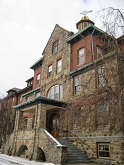 |
Williamson College of the Trades (Williamson Free School of Mechanical Trades)Williamson College of Trades, formerly the Williamson Free School of Mechanical Trades, in Middletown Township, Pennsylvania (Delaware County), was established in 1888 with an endowment from Philadelphia merchant and philanthropist Isaiah V. Williamson. The school's mission is to prepare deserving young men to be useful and respected members of society. The tuition-free school initially offered vocational training for high school-aged young men in areas such as bricklaying, carpentry, and machine shop. Since becoming a post-secondary institution in 1961, the school now offers associate degrees in various fields of specialized technology. The School's archival holdings encompass about 165 linear feet of materials dating from 1764 to 2008, including administrative and financial records of the School, financial papers of school founder Isaiah V. Williamson, and research files compiled by Cornelia Hennigan while she wrote her book on the history of the School.
|
 |
The Wilma TheaterThe Wilma Theater was established in Philadelphia, Pennsylvania in 1973 as the Wilma Project with the purpose of creating theatrical productions of original material and developing local artists. In 1981, the Wilma's artistic leadership was taken over by Blanka (1954-) and Jiri (1953-2012) Zizka, natives of Czechoslovakia who had started their relationship with the Wilma as artists-in-residence in 1979. The Zizkas helped to establish the Wilma as a theater for provocative productions, both American and international. The Wilma Theater's archival holdings, which span 150 linear feet of materials and date from 1978 to the present, consist of its organizational records, including press and public relation files, marketing materials, production files, stage manager files, audiovisual materials, and other materials relating to The Wilma Theater, its staff, and its various productions.
|
 |
Wissahickon Valley Historical SocietyFounded in 1975 and located in Blue Bell, the Wissahickon Valley Historical Society's purpose is to preserve the local historical buildings, artifacts, and folklore of the historic Wissahickon Valley and the Wissahickon School District in Montgomery County, Pennsylvania. The Society's coverage area includes the Borough of Ambler, the Townships of Whitpain and Lower Gwynedd, and the villages of Blue Bell, Broad Axe, Center Square, and Penllyn. The Society houses over 40 linear feet of archival materials, including ephemera, photographs, receipts, pamphlets, newspaper clippings, deeds, maps, and organization records dealing with local businesses, schools, churches, and events. The Historical Society of Whitpain and its collections and property were merged into the Wissahickon Valley Historical Society as of January 1, 2015.
|
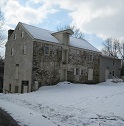 |
Wissahickon Valley Watershed AssociationThe Wissahickon Valley Watershed Association (WVWA), based in eastern Montgomery County, Pennsylvania, is a non-profit land trust founded in 1957 to protect the quality and beauty of the Wissahickon Creek. WVWA stewards several historic buildings, including the Evans-Mumbower Mill, which it acquired in 1987. WVWA holds two small collections of archival materials related to the mill: Mumbower's Mill ledgers, 1851-1920, which document the operations of the grist mill while it was under the ownership of the Mumbower family; and Mumbower family papers, 1927-1950, consisting principally of a family photograph album and a binder on Mumbower family reunions.
|
 |
Woodford MansionWoodford Mansion is a National Historic Landmark located in Fairmount Park in Philadelphia. Built as a country home in 1756-58 by William Coleman, a Philadelphia merchant and close friend of Benjamin Franklin, Woodford is one of the most elegant survivors of the summer retreats built along the Schuylkill River by Philadelphia's well-to-do in the eighteenth and early nineteenth centuries. Woodford is owned by the Philadelphia Parks and Recreation Department and has been operated by the Naomi Wood Trust since 1926. The house is furnished with an extraordinary collection of antiques begun by Naomi Wood, a Philadelphia-born collector. Woodford Mansion's archival holdings total approximately 10 linear feet of records of the Naomi Wood Trust, primarily photographs and records of the antique furnishings provided by the Trust.
|
 |
Woodlands Mansion and CemeteryThe Woodlands is a historic mansion and cemetery in West Philadelphia. Built circa 1770 by William Hamilton and enlarged by him in 1786-1792, the mansion is one of the nation's most sophisticated neoclassical houses from the years following the American Revolution. The Woodlands Cemetery Company was founded in 1840, when it purchased the estate. The Woodlands was a favorite destination for Victorian outings and is the final resting place of many famous Philadelphians.
The collective mission of the Woodlands Cemetery Company of Philadelphia and the Woodlands Trust for Historic Preservation is to preserve and interpret its nationally significant cultural landscape, historic buildings, and cemetery and to make them available to the public as vital educational, environmental, and community resources. The Woodlands houses about 80 linear feet of burial and administrative records of the Woodlands Cemetery Company, 1843-2008.
|
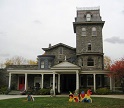 |
Woodmere Art MuseumWoodmere Art Museum, housed in a nineteenth-century stone mansion in the Chestnut Hill neighborhood of Philadelphia, Pennsylvania, tells the story of Philadelphia's art and artists. First opened to the public in 1910, the building, grounds, and core of the museum's permanent collection were the gifts of Charles Knox Smith (1845-1916), a Philadelphia businessman, civic leader, and art collector. Woodmere continues to honor and interpret Smith's vision of bringing art and nature together. Its collection consists of more than 6,000 works of art, the core of which includes important paintings by renowned Philadelphia-area artists. Woodmere's archival holdings total some 320 linear feet of materials dating from 1882 to 2016, including the museum's records and the papers of artists and art collectors.
|
 |
Worcester Historical SocietyThe mission of the Worcester Historical Society is to tell the story of life in Worcester Township during the second half of the 19th century and continuing to the present. By collecting and preserving artifacts of that period, it will give future generations insight into that society, its people, their family life, education, industry, and especially farming. Worcester Township was established in 1733 and is comprised of three villages: Center Point (the geographical center of Montgomery County), Fairview Village, and Cedars (formerly Cedar Hills). Farming has always been central to life in Worcester Township. The Worcester Historical Society collects documents and artifacts relating to the history of Worcester Township. Its archival holdings total some 30 linear feet of materials dating from 1788 to the present, including ledgers, scrapbooks, photographs, letters, receipts, certificates, maps, deeds, and other historical papers.
|
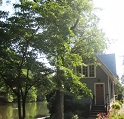 |
Yardley Historical AssociationThe Colonial Yardley Historical Association was formed in the Borough of Yardley, Bucks County, Pennsylvania in 1964 after interest in preserving the community's history was stimulated by a 1963 "Canal Days" celebration. In 1970, the organization adopted "Yardley Historical Association, Inc." as its official name. At its headquarters in the Old Library by Lake Afton in Yardley, the Association maintains an archival collection of over 75 linear feet of material dating from 1741 to the present, with most of the materials documenting the 19th and 20th centuries. Holdings include materials such as minutes, ledgers, scrapbooks, personal papers, photographs (including a significant amount of photographs from the "Yardley News" newspaper), and oral histories that document Yardley individuals, families, organizations, businesses, and events. Of special interest are records of Yardley Borough, Yardley Library Company, Yardley Civic Club, and the Woman's Christian Temperance Union (WCTU) of Yardley.
|